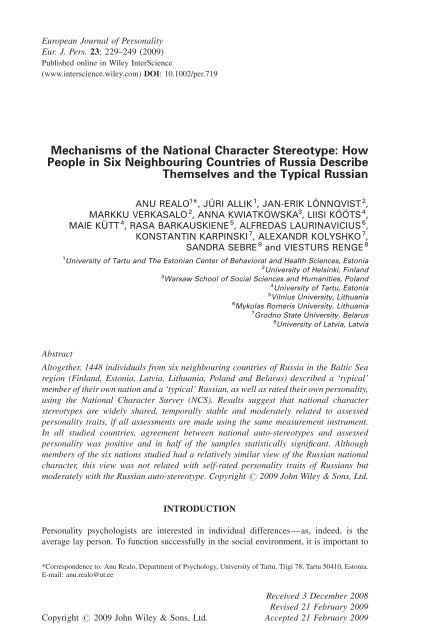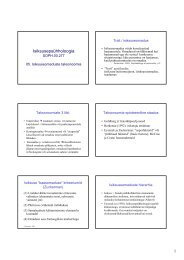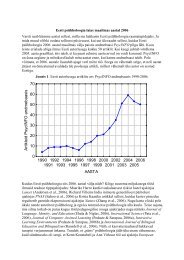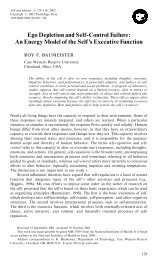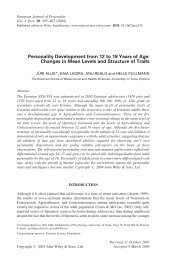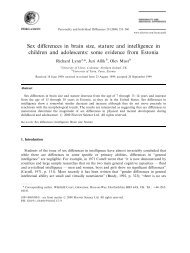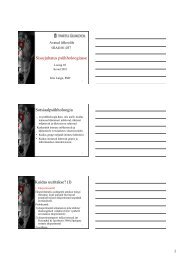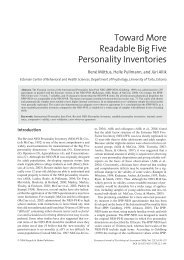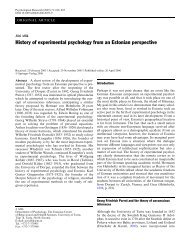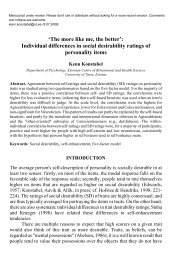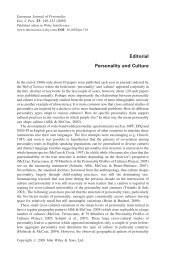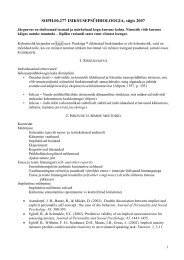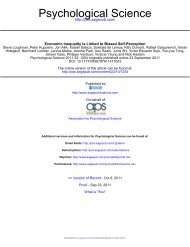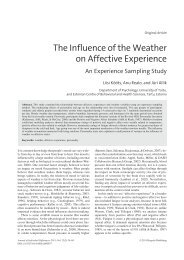Mechanisms of the national character stereotype: How people in six ...
Mechanisms of the national character stereotype: How people in six ...
Mechanisms of the national character stereotype: How people in six ...
Create successful ePaper yourself
Turn your PDF publications into a flip-book with our unique Google optimized e-Paper software.
European Journal <strong>of</strong> Personality<br />
Eur. J. Pers. 23: 229–249 (2009)<br />
Published onl<strong>in</strong>e <strong>in</strong> Wiley InterScience<br />
(www.<strong>in</strong>terscience.wiley.com) DOI: 10.1002/per.719<br />
<strong>Mechanisms</strong> <strong>of</strong> <strong>the</strong> National Character Stereotype: <strong>How</strong><br />
People <strong>in</strong> Six Neighbour<strong>in</strong>g Countries <strong>of</strong> Russia Describe<br />
Themselves and <strong>the</strong> Typical Russian<br />
ANU REALO 1 *,JÜRI ALLIK 1 , JAN-ERIK LÖNNQVIST 2 ,<br />
MARKKU VERKASALO 2 , ANNA KWIATKOWSKA 3 , LIISI KÖÖTS 4 ,<br />
MAIE KÜTT 4 , RASA BARKAUSKIENE 5 , ALFREDAS LAURINAVICIUS 6 ,<br />
KONSTANTIN KARPINSKI 7 , ALEXANDR KOLYSHKO 7 ,<br />
SANDRA SEBRE 8 and VIESTURS RENGE 8<br />
1 University <strong>of</strong> Tartu and The Estonian Center <strong>of</strong> Behavioral and Health Sciences, Estonia<br />
2 University <strong>of</strong> Hels<strong>in</strong>ki, F<strong>in</strong>land<br />
3 Warsaw School <strong>of</strong> Social Sciences and Humanities, Poland<br />
4 University <strong>of</strong> Tartu, Estonia<br />
5 Vilnius University, Lithuania<br />
6 Mykolas Romeris University, Lithuania<br />
7 Grodno State University, Belarus<br />
8 University <strong>of</strong> Latvia, Latvia<br />
Abstract<br />
Altoge<strong>the</strong>r, 1448 <strong>in</strong>dividuals from <strong>six</strong> neighbour<strong>in</strong>g countries <strong>of</strong> Russia <strong>in</strong> <strong>the</strong> Baltic Sea<br />
region (F<strong>in</strong>land, Estonia, Latvia, Lithuania, Poland and Belarus) described a ‘typical’<br />
member <strong>of</strong> <strong>the</strong>ir own nation and a ‘typical’ Russian, as well as rated <strong>the</strong>ir own personality,<br />
us<strong>in</strong>g <strong>the</strong> National Character Survey (NCS). Results suggest that <strong>national</strong> <strong>character</strong><br />
<strong>stereotype</strong>s are widely shared, temporally stable and moderately related to assessed<br />
personality traits, if all assessments are made us<strong>in</strong>g <strong>the</strong> same measurement <strong>in</strong>strument.<br />
In all studied countries, agreement between <strong>national</strong> auto-<strong>stereotype</strong>s and assessed<br />
personality was positive and <strong>in</strong> half <strong>of</strong> <strong>the</strong> samples statistically significant. Although<br />
members <strong>of</strong> <strong>the</strong> <strong>six</strong> nations studied had a relatively similar view <strong>of</strong> <strong>the</strong> Russian <strong>national</strong><br />
<strong>character</strong>, this view was not related with self-rated personality traits <strong>of</strong> Russians but<br />
moderately with <strong>the</strong> Russian auto-<strong>stereotype</strong>. Copyright # 2009 John Wiley & Sons, Ltd.<br />
INTRODUCTION<br />
Personality psychologists are <strong>in</strong>terested <strong>in</strong> <strong>in</strong>dividual differences—as, <strong>in</strong>deed, is <strong>the</strong><br />
average lay person. To function successfully <strong>in</strong> <strong>the</strong> social environment, it is important to<br />
*Correspondence to: Anu Realo, Department <strong>of</strong> Psychology, University <strong>of</strong> Tartu, Tiigi 78, Tartu 50410, Estonia.<br />
E-mail: anu.realo@ut.ee<br />
Copyright # 2009 John Wiley & Sons, Ltd.<br />
Received 3 December 2008<br />
Revised 21 February 2009<br />
Accepted 21 February 2009
230 A. Realo et al.<br />
know whe<strong>the</strong>r we can trust a salesperson, how a new boss will react to our jokes, and<br />
what response we could expect from a friend <strong>in</strong> a critical situation. But <strong>people</strong> are<br />
<strong>in</strong>cl<strong>in</strong>ed to describe groups <strong>of</strong> <strong>people</strong>, a whole nation for example, as if <strong>the</strong>y also had a<br />
dist<strong>in</strong>ctive set <strong>of</strong> personality traits. For example, it is widely believed that F<strong>in</strong>ns are silent,<br />
British <strong>people</strong> are reserved and Italians are emotionally expressive. If such beliefs prevail<br />
among members <strong>of</strong> a social group, <strong>the</strong>se viewpo<strong>in</strong>ts are usually referred to as <strong>stereotype</strong>s.<br />
National <strong>stereotype</strong>s, ei<strong>the</strong>r favourable or unfavourable, are <strong>of</strong>ten reflected <strong>in</strong> jokes and<br />
travellers’ stories; <strong>the</strong>y appear to be most endur<strong>in</strong>g and it is difficult to conv<strong>in</strong>ce those who<br />
believe <strong>in</strong> <strong>the</strong>m that F<strong>in</strong>ns, for <strong>in</strong>stance, are <strong>in</strong> fact ra<strong>the</strong>r talkative or that British <strong>people</strong> are<br />
actually quite jovial and outgo<strong>in</strong>g. Thus, nations and ethnic groups, just like <strong>in</strong>dividuals,<br />
are perceived to have a dist<strong>in</strong>ct <strong>character</strong>, which can be described <strong>in</strong> terms <strong>of</strong> personality<br />
traits.<br />
Researchers have suspected that, although some <strong>stereotype</strong>s may be unfounded, <strong>in</strong><br />
most cases <strong>the</strong>y exaggerate some personality <strong>character</strong>istics that do <strong>in</strong> fact exist.<br />
Accord<strong>in</strong>g to <strong>the</strong> standard def<strong>in</strong>ition, ‘a <strong>stereotype</strong> is an exaggerated belief associated with<br />
a category’ (Allport, 1978/1954, p. 191). This def<strong>in</strong>ition implies that <strong>stereotype</strong>s, <strong>in</strong><br />
general, have a ‘kernel <strong>of</strong> truth’. Thus, beliefs about a particular nation be<strong>in</strong>g punctual can<br />
be verified through observations <strong>of</strong> how accurate public clocks <strong>in</strong> <strong>the</strong> country are, or how<br />
accurate <strong>people</strong> <strong>in</strong> <strong>the</strong> country are <strong>in</strong> report<strong>in</strong>g <strong>the</strong> time on <strong>the</strong>ir watches (Lev<strong>in</strong>e, West, &<br />
Reis, 1980). Ano<strong>the</strong>r possibility is to compare beliefs about <strong>the</strong> <strong>national</strong> <strong>character</strong> with<br />
assessed personality traits among members <strong>of</strong> <strong>the</strong> nation: <strong>the</strong> typical American is believed<br />
to be an achiever and Americans <strong>in</strong>deed score higher than some o<strong>the</strong>r nations on an<br />
achievement scale when <strong>the</strong>y are asked to rate <strong>the</strong>ir own personality traits (Abate &<br />
Berrien, 1967).<br />
For that reason it was a surpris<strong>in</strong>g discovery that beliefs about <strong>national</strong> <strong>stereotype</strong>s<br />
generally do not correspond to aggregated personality traits (Terracciano et al., 2005). In<br />
Terracciano et al.’s (2005) study, respondents from 49 nations described <strong>the</strong> personality <strong>of</strong> a<br />
typical member <strong>of</strong> <strong>the</strong>ir nation (<strong>the</strong> <strong>in</strong>group). When mean <strong>national</strong> <strong>character</strong> pr<strong>of</strong>iles were<br />
compared with mean personality rat<strong>in</strong>gs <strong>of</strong> members <strong>of</strong> <strong>the</strong> same nations, <strong>in</strong> most cases<br />
<strong>the</strong>re was no correlation between <strong>the</strong> two pr<strong>of</strong>iles. This result seems to imply that <strong>the</strong><br />
‘kernel <strong>of</strong> truth’ <strong>the</strong>ory may be not universally applicable, at least <strong>in</strong> terms <strong>of</strong> <strong>national</strong><br />
<strong>character</strong> <strong>stereotype</strong>s. Clearly troubled by this f<strong>in</strong>d<strong>in</strong>g, some researchers have argued that<br />
<strong>national</strong> <strong>stereotype</strong>s cannot be compared with aggregate self-report or observer-report<br />
data, as it may be <strong>the</strong> self- or o<strong>the</strong>r-rat<strong>in</strong>gs, not <strong>the</strong> <strong>stereotype</strong> rat<strong>in</strong>gs, that are biased and<br />
<strong>in</strong>valid (Ashton, 2007; He<strong>in</strong>e, Buchtel, & Norenzayan, 2008; Perug<strong>in</strong>i & Richet<strong>in</strong>, 2007). It<br />
was also proposed, as a <strong>the</strong>oretical possibility, that <strong>stereotype</strong>s about <strong>the</strong> <strong>character</strong> <strong>of</strong> o<strong>the</strong>r<br />
nations are accurate, but that <strong>stereotype</strong>s <strong>people</strong> hold about <strong>the</strong>ir own nation are not<br />
(Rob<strong>in</strong>s, 2005). Although <strong>the</strong>re are many plausible explanations for <strong>the</strong> fact that<br />
<strong>stereotype</strong>s do not reflect aggregated tendencies to th<strong>in</strong>k, feel and behave <strong>in</strong> a <strong>character</strong>istic<br />
way, one obvious consequence <strong>of</strong> many <strong>of</strong> <strong>the</strong>se explanations is that exaggeration <strong>of</strong> typical<br />
traits may not be <strong>the</strong> only mechanism through which <strong>national</strong> <strong>stereotype</strong>s develop.<br />
<strong>How</strong>ever, knowledge about alternative mechanisms is still very limited, ma<strong>in</strong>ly due to <strong>the</strong><br />
lack <strong>of</strong> empirical studies (McCrae, Terracciano, Realo, & Allik, 2007; Terracciano &<br />
McCrae, 2007). This study aims to take a step fur<strong>the</strong>r towards better understand<strong>in</strong>g <strong>the</strong><br />
mechanisms <strong>of</strong> <strong>stereotype</strong> formation by study<strong>in</strong>g <strong>national</strong> <strong>character</strong> <strong>stereotype</strong>s <strong>in</strong> <strong>six</strong><br />
geographically close, yet culturally and historically diverse countries around <strong>the</strong> Baltic<br />
Sea. More specifically, we will exam<strong>in</strong>e both <strong>the</strong> stability and consistency <strong>of</strong> <strong>national</strong><br />
<strong>character</strong> as well as potential mechanisms <strong>of</strong> <strong>national</strong> <strong>stereotype</strong>s.<br />
Copyright # 2009 John Wiley & Sons, Ltd. Eur. J. Pers. 23: 229–249 (2009)<br />
DOI: 10.1002/per
National <strong>character</strong> <strong>stereotype</strong>s 231<br />
Stability <strong>of</strong> <strong>stereotype</strong>s<br />
In a sem<strong>in</strong>al study, Pr<strong>in</strong>ceton University students were asked to select five personality<br />
traits, from a list <strong>of</strong> 84, that <strong>in</strong> <strong>the</strong>ir op<strong>in</strong>ion best described 10 different ethnic and <strong>national</strong><br />
groups (Katz & Braly, 1933). The results demonstrated that students held dist<strong>in</strong>ct beliefs<br />
about each <strong>of</strong> <strong>the</strong> ethnic groups and that <strong>the</strong>re was a relatively high degree <strong>of</strong> agreement<br />
between different judges. Several replications and extensions <strong>of</strong> <strong>the</strong> Pr<strong>in</strong>ceton trilogy<br />
(Gilbert, 1951; Karl<strong>in</strong>s, C<strong>of</strong>fman, & Walters, 1969; Katz & Braly, 1933) over <strong>the</strong> follow<strong>in</strong>g<br />
60 years have shown that it takes decades to change <strong>the</strong> content <strong>of</strong> <strong>national</strong> <strong>stereotype</strong>s<br />
(Madon et al., 2001). These studies, along with more <strong>in</strong>formal observations, seem to<br />
suggest that <strong>national</strong> <strong>stereotype</strong>s are very stable over time and even significant events <strong>in</strong> <strong>the</strong><br />
world political landscape do not radically change <strong>the</strong>ir content, <strong>in</strong> <strong>the</strong> short term, at least.<br />
For example, perceptions <strong>of</strong> <strong>the</strong> ‘typical American’ from 49 cultures around <strong>the</strong> world<br />
before and after <strong>the</strong> Iraq <strong>in</strong>vasion changed very little, even <strong>in</strong> countries like Lebanon,<br />
situated very close to <strong>the</strong> site <strong>of</strong> <strong>the</strong> <strong>in</strong>vasion (Terracciano & McCrae, 2007). Except for<br />
<strong>the</strong>se few studies; however, <strong>in</strong>formation about <strong>the</strong> temporal stability <strong>of</strong> <strong>national</strong> <strong>stereotype</strong>s<br />
is ra<strong>the</strong>r <strong>in</strong>complete. One goal <strong>of</strong> this study is thus to fill <strong>the</strong> gap <strong>in</strong> our knowledge and<br />
provide more detail about <strong>the</strong> temporal stability <strong>of</strong> <strong>stereotype</strong>s.<br />
<strong>Mechanisms</strong> <strong>of</strong> <strong>stereotype</strong>s<br />
S<strong>in</strong>ce exaggeration <strong>of</strong> <strong>character</strong>istic traits observed <strong>in</strong> <strong>the</strong> nation is not a likely device by<br />
which <strong>national</strong> <strong>stereotype</strong>s are created, it is necessary to look for o<strong>the</strong>r candidates. So far<br />
<strong>the</strong> search for a general pr<strong>in</strong>ciple expla<strong>in</strong><strong>in</strong>g how <strong>national</strong> <strong>stereotype</strong>s come <strong>in</strong>to be<strong>in</strong>g has<br />
not been very successful. In some cases it is possible to expla<strong>in</strong> <strong>stereotype</strong>s through an<br />
association between particular aspects <strong>of</strong> <strong>the</strong> <strong>national</strong> <strong>character</strong> and some external<br />
variables. For example, a pervasive correlation between climatic warmth and perceived<br />
<strong>in</strong>terpersonal warmth seems to suggest a metaphorical l<strong>in</strong>k between climate and<br />
personality: o<strong>the</strong>r th<strong>in</strong>gs be<strong>in</strong>g equal, <strong>people</strong> from physically warmer environments are<br />
presumed to be friendlier than those who live <strong>in</strong> colder climates (McCrae et al., 2007). Such<br />
results, however, leave open <strong>the</strong> discourag<strong>in</strong>g conclusion that a mechanism common to all<br />
<strong>national</strong> <strong>stereotype</strong>s may not exist (Terracciano & McCrae, 2007). S<strong>in</strong>ce <strong>national</strong><br />
<strong>stereotype</strong>s are ‘pictures <strong>in</strong> our heads’ (Lippmann, 1922), <strong>the</strong>y are acquired by <strong>in</strong>dividuals<br />
from a number <strong>of</strong> unpredictable sources, such as gossip, anecdotes, books and films. There<br />
may be multiple sources for <strong>the</strong> emergence <strong>of</strong> <strong>national</strong> <strong>stereotype</strong>s and <strong>the</strong>ir orig<strong>in</strong> may<br />
vary from country to country (Terracciano & McCrae, 2007).<br />
Never<strong>the</strong>less, <strong>in</strong> some cases it is possible to deduce what <strong>the</strong> mechanisms <strong>of</strong> <strong>national</strong><br />
<strong>character</strong> <strong>stereotype</strong> formation are. For example, Canadians describe <strong>the</strong>mselves as<br />
agreeable, emotionally stable and timid—<strong>in</strong> direct opposition to how Americans are<br />
perceived by <strong>the</strong>mselves and <strong>the</strong>ir neighbours: mostly arrogant, hostile and assertive<br />
(Terracciano et al., 2005). S<strong>in</strong>ce Canadians perceive <strong>the</strong>ir <strong>national</strong> <strong>character</strong> as an almost<br />
mirror image <strong>of</strong> <strong>the</strong> American <strong>character</strong>, it is very likely that Canadians have come up with<br />
this <strong>stereotype</strong> through opposition to what <strong>the</strong>y th<strong>in</strong>k about Americans (cf. Adams, 2003).<br />
It is improbable that Americans def<strong>in</strong>e <strong>the</strong>mselves <strong>in</strong> reference to Canadians; however, so<br />
<strong>the</strong>ir views must be <strong>of</strong> a different orig<strong>in</strong>. It is also clear that nei<strong>the</strong>r <strong>national</strong> <strong>stereotype</strong><br />
reflects actually observed personality dispositions, which were virtually identical for<br />
Canadians and Americans (Terracciano et al., 2005). Ano<strong>the</strong>r well-documented case <strong>of</strong><br />
Copyright # 2009 John Wiley & Sons, Ltd. Eur. J. Pers. 23: 229–249 (2009)<br />
DOI: 10.1002/per
232 A. Realo et al.<br />
such <strong>stereotype</strong> polarization concerns beliefs about personality traits <strong>in</strong> North versus South<br />
Italy (McCrae et al., 2007).<br />
There are several reasons to believe that polarization <strong>of</strong> <strong>stereotype</strong>s <strong>in</strong> neighbour<strong>in</strong>g<br />
cultures is quite common. It has been observed that <strong>stereotype</strong>s are <strong>of</strong>ten compensatory <strong>in</strong><br />
nature: <strong>the</strong> target country is perceived as warmer but less competent when <strong>the</strong> comparison<br />
country is stereotypically high (vs. low) <strong>in</strong> competence and low (vs. high) <strong>in</strong> warmth<br />
(Kervyn, Yzerbyt, Demoul<strong>in</strong>, & Judd, 2008). In <strong>the</strong> same way, it can be expected that<br />
Russia, like <strong>the</strong> United States, has played a significant role <strong>in</strong> <strong>the</strong> formation <strong>of</strong> <strong>national</strong><br />
<strong>stereotype</strong>s <strong>in</strong> countries border<strong>in</strong>g it. Besides be<strong>in</strong>g a dom<strong>in</strong>ant political and cultural force<br />
<strong>in</strong> <strong>the</strong> region, Russia is believed to belong to a completely different cultural tradition than<br />
many <strong>of</strong> its neighbours. Several political scientists, both before and s<strong>in</strong>ce <strong>the</strong> collapse <strong>of</strong> <strong>the</strong><br />
Soviet Union, have proposed <strong>the</strong> view that <strong>the</strong> cultural dist<strong>in</strong>ction between Russia and its<br />
more Western neighbours is <strong>in</strong>surmountable, rooted <strong>in</strong> <strong>the</strong> <strong>in</strong>compatibility <strong>of</strong> two different<br />
types <strong>of</strong> civilization (Hunt<strong>in</strong>gton, 1993). For this reason, Russia is <strong>of</strong>ten perceived by its<br />
neighbours not only as a dom<strong>in</strong>ant political power but as a constant threat to <strong>the</strong> exist<strong>in</strong>g<br />
cultural traditions <strong>of</strong> <strong>the</strong>se countries. In Estonia, one <strong>of</strong> Russia’s neighbour<strong>in</strong>g nations, for<br />
<strong>in</strong>stance, <strong>the</strong>re is a popularly held belief that Estonians are passionately <strong>in</strong>dividualistic<br />
(Realo, 1998, 2003). Such a belief; however, seems to be based on a comparison with<br />
Russians, who are usually portrayed as quite collectivistic (Realo, 1998). In a similar ve<strong>in</strong>,<br />
studies have shown that when asked about <strong>the</strong> <strong>national</strong> <strong>character</strong> <strong>stereotype</strong>s <strong>of</strong> <strong>six</strong> ethnic<br />
groups (Estonians, Jews, Latvians, Germans, F<strong>in</strong>ns and Russians), Estonian students depict<br />
Russians as <strong>the</strong> anti<strong>the</strong>sis <strong>of</strong> Estonians—Estonians are seen as selfish, superior, ironic,<br />
conscientious, <strong>in</strong>telligent and honest, whereas Russians are described as helpful,<br />
sympa<strong>the</strong>tic, friendly, but also less conscientious and not particularly smart (Valk, 1998).<br />
It is likely that most <strong>national</strong> <strong>stereotype</strong>s are acquired by word <strong>of</strong> mouth, through<br />
everyday experience. When a large nation has played a dom<strong>in</strong>ant role <strong>in</strong> <strong>the</strong> political and<br />
everyday life <strong>of</strong> its neighbours, it is expected that this pre-em<strong>in</strong>ence will have left some<br />
traces <strong>in</strong> <strong>the</strong> way <strong>in</strong> which neighbours th<strong>in</strong>k about <strong>the</strong>mselves as well as <strong>the</strong>ir <strong>in</strong>fluential<br />
neighbours. For example, it has been observed that neighbours (Poles, F<strong>in</strong>ns, Hungarians<br />
and Czechs) who have been <strong>in</strong>vaded by <strong>the</strong> Russians see <strong>the</strong>m both as less modern and less<br />
self-controlled than <strong>the</strong>y are seen elsewhere (Boster & Maltseva, 2006). It is not entirely<br />
improbable, fur<strong>the</strong>rmore, that <strong>the</strong>se <strong>stereotype</strong>s about <strong>the</strong>ir powerful neighbour are<br />
somehow reflected <strong>in</strong> <strong>the</strong>ir own <strong>national</strong> <strong>stereotype</strong>s. Indeed, <strong>the</strong> nations liv<strong>in</strong>g on shores <strong>of</strong><br />
<strong>the</strong> Baltic Sea not only share some common attributes between <strong>the</strong>ir o<strong>the</strong>rwise very<br />
different languages, such as vowel harmony (Jakobson, 1931/1962), but also a history <strong>of</strong><br />
susta<strong>in</strong>ed contact with <strong>the</strong> Russians. There are sharp differences among neighbour<strong>in</strong>g<br />
countries <strong>of</strong> Russia on <strong>the</strong> shores <strong>of</strong> <strong>the</strong> Baltic Sea <strong>in</strong> terms <strong>of</strong> everyday contact with<br />
Russians; however, due to clear differences <strong>in</strong> <strong>the</strong> ethnic composition <strong>of</strong> <strong>the</strong> various<br />
populations. For example, Russians constitute 29 and 26% <strong>of</strong> population <strong>in</strong> Latvia and<br />
Estonia, respectively, while <strong>in</strong> Poland and F<strong>in</strong>land <strong>the</strong> Russian population is less than 1%.<br />
But <strong>of</strong> course, contact with Russians <strong>in</strong> <strong>the</strong> countries <strong>in</strong> our study is not limited to <strong>the</strong>ir<br />
share <strong>in</strong> <strong>the</strong> population. Poland, for <strong>in</strong>stance, has a long history <strong>of</strong> shopp<strong>in</strong>g and transit<br />
tourism, with large numbers <strong>of</strong> sellers and buyers com<strong>in</strong>g mostly from Russia (as well as<br />
from Belarus and <strong>the</strong> Ukra<strong>in</strong>e). As for F<strong>in</strong>land, over 850 000 Russian tourists visited<br />
F<strong>in</strong>land <strong>in</strong> 2007. F<strong>in</strong>ally, Belarus, out <strong>of</strong> <strong>six</strong> countries <strong>in</strong> our study has <strong>the</strong> closest<br />
associations with Russia—‘<strong>the</strong> preponderant Russophile orientation <strong>in</strong> Belarus stems from<br />
<strong>the</strong> Orthodox cultural tradition, Russia be<strong>in</strong>g <strong>the</strong> prime cultural donor <strong>of</strong> Belarus, and<br />
Russia’s pre-em<strong>in</strong>ent role <strong>in</strong> shap<strong>in</strong>g Belarus’ statehood’ (I<strong>of</strong>fe, 2003, p. 1267).<br />
Copyright # 2009 John Wiley & Sons, Ltd. Eur. J. Pers. 23: 229–249 (2009)<br />
DOI: 10.1002/per
National <strong>character</strong> <strong>stereotype</strong>s 233<br />
Aims <strong>of</strong> this study<br />
The ma<strong>in</strong> aim <strong>of</strong> this study to exam<strong>in</strong>e how <strong>people</strong> <strong>in</strong> <strong>six</strong> neighbour<strong>in</strong>g countries <strong>of</strong> Russia<br />
describe <strong>the</strong>mselves and <strong>the</strong> typical Russian. More specifically, we focussed on <strong>the</strong> follow<strong>in</strong>g<br />
research questions: (1) Do <strong>national</strong> <strong>character</strong> <strong>stereotype</strong>s reflect mean personality<br />
traits? (2) Are <strong>stereotype</strong>s about <strong>the</strong> <strong>character</strong> <strong>of</strong> o<strong>the</strong>r nations accurate? (3) <strong>How</strong> <strong>the</strong> <strong>in</strong>tensity<br />
<strong>of</strong> contact, both actual and symbolic, has affected <strong>the</strong> <strong>national</strong> <strong>character</strong> <strong>stereotype</strong>s <strong>of</strong><br />
Russia’s neighbours located around <strong>the</strong> Baltic Sea? (4) <strong>How</strong> stable are <strong>stereotype</strong>s?<br />
Although results show<strong>in</strong>g that <strong>national</strong> <strong>character</strong> <strong>stereotype</strong>s did not correspond to mean<br />
personality trait levels <strong>in</strong> 49 countries are ra<strong>the</strong>r conv<strong>in</strong>c<strong>in</strong>g (Terracciano et al., 2005), it is<br />
important to note that <strong>in</strong> Terracciano et al.’s (2005) study, <strong>national</strong> <strong>character</strong> was measured<br />
by <strong>the</strong> 30-item National Character Survey (NCS), while personality was rated with <strong>the</strong> 240-<br />
item version <strong>of</strong> <strong>the</strong> Revised NEO Personality Inventory (Costa & McCrae, 1992). While<br />
<strong>the</strong>re is a strong conceptual correspondence between <strong>the</strong>se two <strong>in</strong>struments, <strong>the</strong>re is no<br />
<strong>in</strong>formation on how comparable <strong>the</strong> measures are when adm<strong>in</strong>istered with different<br />
<strong>in</strong>structions. In order to elim<strong>in</strong>ate possible biases <strong>in</strong>herent <strong>in</strong> particular measurement<br />
<strong>in</strong>struments, it would be necessary to measure <strong>national</strong> <strong>character</strong> and self-rated personality<br />
traits with exactly <strong>the</strong> same <strong>in</strong>strument. This is one <strong>of</strong> <strong>the</strong> ma<strong>in</strong> research strategies <strong>of</strong> this<br />
study: we use <strong>the</strong> same measur<strong>in</strong>g <strong>in</strong>strument, specifically <strong>the</strong> NCS, to measure how <strong>people</strong><br />
perceive both a typical member <strong>of</strong> <strong>the</strong>ir nation and a typical Russian, as well as how <strong>the</strong>y<br />
rate <strong>the</strong>ir own personality.<br />
F<strong>in</strong>ally, as mentioned above, we were <strong>in</strong>terested <strong>in</strong> study<strong>in</strong>g <strong>the</strong> temporal stability <strong>of</strong><br />
<strong>stereotype</strong>s. As argued above, it has been shown by several researchers (Madon et al., 2001;<br />
Terracciano & McCrae, 2007) that <strong>national</strong> <strong>character</strong> <strong>stereotype</strong>s appear to be relatively<br />
durable phenomena. Yet, it should be noted that <strong>the</strong> data collection <strong>in</strong>terval <strong>in</strong> Terracciano<br />
and McCrae’s study (2007) was only 3–6 months. In this study, we had <strong>the</strong> opportunity to<br />
exam<strong>in</strong>e <strong>the</strong> stability <strong>of</strong> <strong>stereotype</strong>s <strong>in</strong> two countries—Estonia and Poland—across a time<br />
<strong>in</strong>terval <strong>of</strong> 5 years, by compar<strong>in</strong>g our data with those reported by Terracciano et al. (2005).<br />
METHOD<br />
Participants<br />
Altoge<strong>the</strong>r, 1320 college students <strong>in</strong> <strong>the</strong> social sciences and <strong>the</strong> humanities (933 women,<br />
385 men and 2 participants who did not report <strong>the</strong>ir gender, mean age ¼ 22.1, SD ¼ 3.5)<br />
and 128 work<strong>in</strong>g adults (77 women and 51 men, mean age ¼ 31.6, SD ¼ 7.3) from <strong>six</strong><br />
neighbour<strong>in</strong>g countries <strong>in</strong> <strong>the</strong> Baltic Sea region (F<strong>in</strong>land, Estonia, Latvia, Lithuania,<br />
Poland and Belarus) participated <strong>in</strong> this research. All <strong>the</strong>se countries have a border with<br />
Russia: F<strong>in</strong>land, Estonia, Latvia and Belarus border with ma<strong>in</strong>land Russia, whereas<br />
Lithuania and Poland border with <strong>the</strong> Russian enclave <strong>of</strong> <strong>the</strong> Kal<strong>in</strong><strong>in</strong>grad Oblast. All<br />
participants volunteered for <strong>the</strong> study. Students were assessed <strong>in</strong> group sessions <strong>in</strong> lecture<br />
rooms <strong>of</strong> <strong>the</strong>ir respective university or college, except for <strong>the</strong> F<strong>in</strong>nish sample, which<br />
completed <strong>the</strong> questionnaire onl<strong>in</strong>e. Work<strong>in</strong>g adults were tested <strong>in</strong>dividually or <strong>in</strong> small<br />
groups at <strong>the</strong>ir workplace. Data were collected <strong>in</strong> spr<strong>in</strong>g 2008.<br />
F<strong>in</strong>nish sample<br />
The F<strong>in</strong>nish sample consisted <strong>of</strong> 286 undergraduate (social science) students (247 women<br />
and 39 men) from <strong>the</strong> Universities <strong>of</strong> Hels<strong>in</strong>ki, Turku, Jyväskylä, Tampere and Joensuu.<br />
Copyright # 2009 John Wiley & Sons, Ltd. Eur. J. Pers. 23: 229–249 (2009)<br />
DOI: 10.1002/per
234 A. Realo et al.<br />
The mean age <strong>of</strong> participants was 24.4 years (SD ¼ 5.8). The F<strong>in</strong>nish version <strong>of</strong> <strong>the</strong><br />
questionnaire was adm<strong>in</strong>istered over <strong>the</strong> Internet.<br />
Estonian sample<br />
The Estonian sample consisted <strong>of</strong> two subsamples: students and work<strong>in</strong>g adults from an<br />
Estonian real estate company. Two-hundred and one Estonian undergraduate students (129<br />
women and 72 men) enrolled <strong>in</strong> various <strong>in</strong>troductory psychology classes at <strong>the</strong> University<br />
<strong>of</strong> Tartu participated <strong>in</strong> this project. The mean age <strong>of</strong> <strong>the</strong> students was 21.2 years<br />
(SD ¼ 2.3). The work<strong>in</strong>g adult sample consisted <strong>of</strong> 74 <strong>in</strong>dividuals (44 women and 30 men)<br />
with a mean age <strong>of</strong> 33.8 years (SD ¼ 7.2). The <strong>in</strong>structions were given <strong>in</strong> Estonian and <strong>the</strong><br />
participants completed <strong>the</strong> Estonian version <strong>of</strong> <strong>the</strong> questionnaire.<br />
Latvian sample<br />
The Latvian sample consisted <strong>of</strong> 200 undergraduate students (158 women and 42 men;<br />
21.0% males; mean age ¼ 22.1 years, SD ¼ 3.0) <strong>in</strong> <strong>the</strong> social sciences and <strong>the</strong> humanities<br />
from <strong>the</strong> University <strong>of</strong> Latvia and <strong>of</strong> 54 work<strong>in</strong>g adults (33 women and 21 men; mean<br />
age ¼ 28.5 years, SD ¼ 6.5) from <strong>the</strong> Latvian <strong>of</strong>fice <strong>of</strong> <strong>the</strong> same (Estonian) real estate<br />
company used <strong>in</strong> <strong>the</strong> Estonian sample. The language <strong>of</strong> <strong>in</strong>structions and <strong>of</strong> <strong>the</strong><br />
questionnaire itself was Latvian.<br />
Lithuanian sample<br />
The Lithuanian sample consisted <strong>of</strong> 204 students (110 women, 93 men and 1 <strong>in</strong>dividual<br />
who did not report his/her gender) from <strong>the</strong> Mykolas Romeris University. Participants were<br />
students <strong>in</strong> <strong>the</strong> social sciences, with a mean age 20.6 years (SD ¼ 0.9), rang<strong>in</strong>g between<br />
19 and 24 years. They were <strong>in</strong>structed, and completed <strong>the</strong> questionnaire, <strong>in</strong> Lithuanian.<br />
Polish sample<br />
Participants <strong>in</strong> <strong>the</strong> Polish sample were 229 undergraduate students (189 women, 39 men<br />
and 1 respondent who did not report his/her gender) from <strong>the</strong> Warsaw School <strong>of</strong> Social<br />
Sciences and Humanities Psychology and <strong>the</strong> University <strong>of</strong> Bialystok. Participants were<br />
students <strong>of</strong> psychology and <strong>the</strong> educational sciences, with a mean age 22.2 years<br />
(SD ¼ 2.0), rang<strong>in</strong>g between 19 and 32 years. The language <strong>of</strong> <strong>in</strong>structions and <strong>the</strong><br />
questionnaire itself was Polish.<br />
Belarusian sample<br />
The Belarusian sample consisted <strong>of</strong> 200 students (100 women and 100 men) from <strong>the</strong><br />
Grodno State University. Participants’ ages ranged between 18 and 26, with a mean age <strong>of</strong><br />
20.9 years (SD ¼ 1.5). Participants were students <strong>of</strong> <strong>the</strong> social sciences, l<strong>in</strong>guistics and<br />
economics. The <strong>in</strong>structions were given <strong>in</strong> Russian and <strong>the</strong> participants completed <strong>the</strong><br />
Russian version <strong>of</strong> <strong>the</strong> questionnaire.<br />
F<strong>in</strong>ally, for purposes <strong>of</strong> comparison, we used data from <strong>the</strong> Russian Character and<br />
Personality Survey (RCPS), which <strong>in</strong>volved 40 universities and colleges from across <strong>the</strong><br />
Russian Federation (Allik et al., 2009). Three thousand seven hundred and five participants<br />
with a mean age <strong>of</strong> 20.7 years (SD ¼ 2.9 years, 75% <strong>of</strong> <strong>the</strong>m women) were asked to rate a<br />
typical Russian liv<strong>in</strong>g <strong>in</strong> <strong>the</strong>ir region on <strong>the</strong> NCS scales. We used data from this and an<br />
additional group <strong>of</strong> participants (total N ¼ 10 672) which also used NCS to rate <strong>the</strong>ir own<br />
personality. Both groups <strong>of</strong> respondents were given similar <strong>in</strong>structions as <strong>in</strong> this study.<br />
Copyright # 2009 John Wiley & Sons, Ltd. Eur. J. Pers. 23: 229–249 (2009)<br />
DOI: 10.1002/per
National <strong>character</strong> <strong>stereotype</strong>s 235<br />
Questionnaire and <strong>in</strong>structions<br />
The NCS (Terracciano et al., 2005) consists <strong>of</strong> 30 bipolar items <strong>in</strong>tended to parallel <strong>the</strong><br />
facets <strong>of</strong> <strong>the</strong> NEO-PI-R (Costa & McCrae, 1992). For example, <strong>the</strong> Neuroticism facet,<br />
depression, was assessed by ask<strong>in</strong>g how likely, on a five-po<strong>in</strong>t scale, <strong>the</strong> typical F<strong>in</strong>n was to<br />
be depressed, sad and pessimistic versus contented and optimistic. The NCS was already<br />
available <strong>in</strong> Estonian, Polish and Russian (Terracciano et al., 2005) and was translated <strong>in</strong>to<br />
F<strong>in</strong>nish, Latvian and Lithuanian for <strong>the</strong> purposes <strong>of</strong> this study by bil<strong>in</strong>gual colleagues.<br />
Translators were <strong>in</strong>structed to choose words or phrases that best conveyed <strong>the</strong> <strong>in</strong>tended<br />
construct, us<strong>in</strong>g <strong>the</strong> description <strong>of</strong> <strong>the</strong> 30 facets from <strong>the</strong> NEO-PI-R manual for reference<br />
(Costa & McCrae, 1992). Robert R. McCrae, one <strong>of</strong> <strong>the</strong> two authors <strong>of</strong> <strong>the</strong> NCS, exam<strong>in</strong>ed<br />
<strong>in</strong>dependent back-translations <strong>in</strong>to English, and any items that appeared problematic were<br />
reconsidered by <strong>the</strong> translators.<br />
The questionnaire was adm<strong>in</strong>istered <strong>in</strong> three steps to assure that respondents did not<br />
know that <strong>the</strong>y were rat<strong>in</strong>g two target nations and <strong>the</strong>mselves before <strong>the</strong>y started. In each<br />
sample, we asked respondents to complete <strong>the</strong> NCS by, firstly, describ<strong>in</strong>g a typical member<br />
<strong>of</strong> <strong>the</strong>ir own nation (e.g. ‘F<strong>in</strong>ns are likely ...’). When everyone had f<strong>in</strong>ished, respondents<br />
were asked to turn to <strong>the</strong> next page and to write ‘Russians are likely to be ...’ at <strong>the</strong> top <strong>of</strong><br />
<strong>the</strong> page and to complete <strong>the</strong> survey just as <strong>the</strong>y did before. F<strong>in</strong>ally, participants were once<br />
more asked to turn to <strong>the</strong> next page, to write ‘Iam...’ at <strong>the</strong> top <strong>of</strong> <strong>the</strong> page and to rate <strong>the</strong>ir<br />
own personality us<strong>in</strong>g <strong>the</strong> same set <strong>of</strong> 30 NCS items. NCS scores for <strong>the</strong> five factors were<br />
calculated as <strong>the</strong> sum <strong>of</strong> <strong>the</strong> <strong>six</strong> relevant facets.<br />
Internal consistency<br />
Analyses <strong>of</strong> <strong>the</strong> 1448 <strong>in</strong>dividual responses from <strong>the</strong> total sample <strong>in</strong>dicated that Cronbach’s<br />
a for <strong>the</strong> five factor scales <strong>of</strong> <strong>the</strong> NCS <strong>in</strong>group rat<strong>in</strong>gs were .63, .69, .63, .75 and .73 for<br />
Neuroticism (N), Extraversion (E), Openness to Experience (O), Agreeableness (A) and<br />
Conscientiousness (C), respectively. For <strong>the</strong> rat<strong>in</strong>gs <strong>of</strong> typical Russians, Cronbach’s a <strong>of</strong><br />
<strong>the</strong> abovementioned five factor scales were .45, .69, .66, .71 and .76. F<strong>in</strong>ally, <strong>the</strong> reliability<br />
coefficients <strong>of</strong> self-rat<strong>in</strong>gs were .67, .74, .56, .63 and .74, respectively. These reliability<br />
coefficients, except for one, are acceptable for a <strong>six</strong>-item scale. Only one <strong>of</strong> <strong>the</strong> scales—<br />
Neuroticism <strong>in</strong> <strong>the</strong> rat<strong>in</strong>gs <strong>of</strong> typical Russians—had a relatively low <strong>in</strong>ternal consistency<br />
coefficient (a ¼ .45). The ma<strong>in</strong> problem occurred with facet N5: Impulsiveness, which had<br />
a virtually zero-correlation with <strong>the</strong> o<strong>the</strong>r five items on <strong>the</strong> N scale. As previously found <strong>in</strong><br />
Russian samples us<strong>in</strong>g <strong>the</strong> NEO-PI-R self- and o<strong>the</strong>r-rat<strong>in</strong>gs (Allik & McCrae, 2004;<br />
Konstabel, Realo, & Kallasmaa, 2002; Mart<strong>in</strong>, Costa, Oryol, Rukavishnikov, & Sen<strong>in</strong>,<br />
2002), N5 was more strongly related with Extraversion (r ¼.23, p < .000) and<br />
Conscientiousness (r ¼ .36, p < .000) than with Neuroticism (r ¼.04, n.s.).<br />
Factor structure<br />
A pr<strong>in</strong>cipal components analysis followed by a varimax normalized rotation was<br />
conducted on <strong>the</strong> 30 items for <strong>the</strong> entire sample <strong>of</strong> 1448 subjects for <strong>the</strong> (1) <strong>in</strong>group rat<strong>in</strong>gs,<br />
(2) rat<strong>in</strong>gs <strong>of</strong> typical Russians and (3) self-rat<strong>in</strong>gs. For <strong>in</strong>group rat<strong>in</strong>gs, five factors had<br />
eigenvalues greater than one, expla<strong>in</strong><strong>in</strong>g 48.4% <strong>of</strong> <strong>the</strong> total variance. For <strong>the</strong> rat<strong>in</strong>gs <strong>of</strong> a<br />
typical Russian and self-rat<strong>in</strong>gs, <strong>six</strong> factors had eigenvalues above one but both a scree-test<br />
and parallel analysis clearly <strong>in</strong>dicated that five factors should be reta<strong>in</strong>ed. The five-factor<br />
solution expla<strong>in</strong>ed 47.8 and 47.9% <strong>of</strong> <strong>the</strong> variance for <strong>the</strong> rat<strong>in</strong>gs <strong>of</strong> typical Russians and<br />
self-rat<strong>in</strong>gs, respectively. In order to exam<strong>in</strong>e how well <strong>the</strong> NCS factor solutions replicated<br />
Copyright # 2009 John Wiley & Sons, Ltd. Eur. J. Pers. 23: 229–249 (2009)<br />
DOI: 10.1002/per
236 A. Realo et al.<br />
<strong>the</strong> NCS structure, as found <strong>in</strong> previous research (Terracciano et al., 2005), exploratory<br />
pr<strong>in</strong>cipal component analyses were followed by Procrustes targeted rotations and by <strong>the</strong><br />
computation <strong>of</strong> an <strong>in</strong>dex <strong>of</strong> factorial agreement across <strong>the</strong> cultural groups (van de Vijver &<br />
Leung, 1997). More specifically, <strong>the</strong> varimax normalized factor load<strong>in</strong>gs were targeted<br />
towards <strong>the</strong> factor structure <strong>of</strong> <strong>the</strong> NCS <strong>in</strong>group rat<strong>in</strong>gs obta<strong>in</strong>ed on <strong>the</strong> <strong>in</strong>ter<strong>national</strong><br />
sample <strong>of</strong> 3989 respondents from 49 different nations (Terracciano et al., 2005). After <strong>the</strong><br />
target rotations were carried out, <strong>the</strong> factorial agreement with <strong>the</strong> <strong>in</strong>ter<strong>national</strong> data was<br />
estimated for all three conditions. The mean coefficients <strong>of</strong> congruence between <strong>the</strong> fivefactor<br />
structures <strong>of</strong> <strong>the</strong> <strong>in</strong>ter<strong>national</strong> data and our sample for Neuroticism, Extraversion,<br />
Openness to Experience, Agreeableness and Conscientiousness were .91, .91, .70, .95 and<br />
.98 (<strong>in</strong>group rat<strong>in</strong>gs), .93, .94, .92, .96 and .96 (rat<strong>in</strong>gs <strong>of</strong> a typical Russian) and .91, .88,<br />
.90, .96 and .95 (self-rat<strong>in</strong>gs), respectively. Thus, nearly all congruence coefficients—<br />
except for two—were above .90, <strong>the</strong>reby provid<strong>in</strong>g a reasonable replication <strong>of</strong> <strong>the</strong><br />
expected factor structure. But even <strong>the</strong>se two somewhat lower coefficients <strong>of</strong> congruence<br />
do not suggest total randomness as <strong>the</strong> means <strong>of</strong> <strong>the</strong> distributions <strong>of</strong> factor congruencies<br />
based on Procrustes rotations <strong>of</strong> randomly permuted data range from .32 to .34 for <strong>the</strong> five<br />
factors <strong>of</strong> personality (McCrae, Zonderman, Costa, Bond, & Paunonen, 1996).<br />
Interjudge reliability<br />
Interjudge reliability between s<strong>in</strong>gle raters showed modest agreement between <strong>in</strong>dividual<br />
judgments <strong>of</strong> <strong>in</strong>group <strong>national</strong> <strong>character</strong>, with coefficients rang<strong>in</strong>g from .02 (C1:<br />
Competence) to .38 (Agreeableness) for <strong>in</strong>group rat<strong>in</strong>gs with a median value <strong>of</strong> .14 for <strong>the</strong><br />
30 facets. This coefficient is slightly lower than what was reported by Terracciano and<br />
colleagues (2005) <strong>in</strong> <strong>the</strong>ir study on <strong>national</strong> <strong>character</strong> <strong>in</strong> 49 countries (median ¼ .17). By<br />
aggregat<strong>in</strong>g <strong>the</strong> judgments <strong>of</strong> an average <strong>of</strong> 181 respondents per sample, reliability coefficients<br />
ranged from .95 (Conscientiousness) to .99 (Agreeableness). Thus, aggregation<br />
across a large sample <strong>of</strong> judges yielded highly reliable values, support<strong>in</strong>g <strong>the</strong> perception<br />
<strong>the</strong>se are shared by <strong>the</strong> group as a whole. Intraclass correlation coefficients were calculated<br />
accord<strong>in</strong>g to <strong>the</strong> follow<strong>in</strong>g formula: reliability <strong>of</strong> (a) s<strong>in</strong>gle raters [ICC(1,1) ¼ MS R MS W /<br />
MS W /MS R þ (k 1) MS W ] and <strong>of</strong> <strong>the</strong> (b) culture–average rat<strong>in</strong>gs [ICC(1,k) ¼ (MS R<br />
MS W )/MS R ], where k is <strong>the</strong> mean number <strong>of</strong> raters per culture, MS R is <strong>the</strong> mean square for<br />
facets and MS W is <strong>the</strong> mean square for residual sources <strong>of</strong> variance <strong>of</strong> an ANOVA model<br />
with cultures as <strong>the</strong> <strong>in</strong>dependent variable (McGraw & Wong, 1996; Terracciano et al., 2005).<br />
Analytic strategy<br />
In this paper we are mostly <strong>in</strong>terested <strong>in</strong> agreement <strong>of</strong> cultures across trait pr<strong>of</strong>iles, not <strong>in</strong><br />
agreement on traits or <strong>in</strong> correlations for <strong>in</strong>dividual traits across cultures. Any two pr<strong>of</strong>iles<br />
may be similar not only because <strong>the</strong>ir dist<strong>in</strong>ctive features are well matched but also because<br />
<strong>the</strong>y both reflect an average pr<strong>of</strong>ile. In order to elim<strong>in</strong>ate or reduce <strong>the</strong> component common<br />
to all rat<strong>in</strong>gs irrespective <strong>of</strong> particular <strong>in</strong>struction, usually called <strong>the</strong> concept <strong>of</strong><br />
‘generalized o<strong>the</strong>r’ (Cronbach, 1955), all NCS <strong>stereotype</strong> scores (i.e. mean rat<strong>in</strong>gs <strong>of</strong> a<br />
typical <strong>in</strong>group member and <strong>of</strong> a ‘typical Russian’) were converted <strong>in</strong>to T-scores us<strong>in</strong>g<br />
mean scores <strong>of</strong> <strong>national</strong> <strong>character</strong> rat<strong>in</strong>gs from 3989 <strong>people</strong> <strong>in</strong> 49 different cultures<br />
(Terracciano et al., 2005). Unfortunately, <strong>the</strong>re are no world norms for self-reports on <strong>the</strong><br />
NCS. Therefore, self-rat<strong>in</strong>gs were standardized us<strong>in</strong>g <strong>the</strong> seven-culture unweighted means<br />
(total N ¼ 12 120) to compensate for <strong>the</strong> very large Russian sample. Thus, <strong>the</strong> mean values<br />
<strong>of</strong> self-rat<strong>in</strong>gs on <strong>the</strong> NCS items were transformed <strong>in</strong>to a dist<strong>in</strong>ctive pr<strong>of</strong>ile which show<br />
Copyright # 2009 John Wiley & Sons, Ltd. Eur. J. Pers. 23: 229–249 (2009)<br />
DOI: 10.1002/per
National <strong>character</strong> <strong>stereotype</strong>s 237<br />
how each <strong>in</strong>dividual culture is above or below average <strong>of</strong> <strong>the</strong> seven studied cultures<br />
(cf. Furr, 2008).<br />
Pr<strong>of</strong>ile agreement, if not o<strong>the</strong>rwise said, was calculated as <strong>the</strong> <strong>in</strong>traclass correlation<br />
(ICC) across <strong>the</strong> 30 facets, us<strong>in</strong>g <strong>the</strong> double-entry method (Griff<strong>in</strong> & Gonzalez, 1995).<br />
Double-entry <strong>in</strong>traclass correlations are similar to Pearson correlations, but <strong>the</strong>y are<br />
sensitive to differences <strong>in</strong> pr<strong>of</strong>ile elevation as well as shape (McCrae, 2008). The p-value is<br />
based on <strong>the</strong> non-doubled n <strong>of</strong> 30.<br />
Abbreviations<br />
Throughout <strong>the</strong> paper we use <strong>the</strong> follow<strong>in</strong>g system <strong>of</strong> abbreviations: BLR ¼ Belarus;<br />
EST ¼ Estonia; FIN ¼ F<strong>in</strong>land; LAT ¼ Latvia; LIT ¼ Lithuania; POL ¼ Poland; RUS ¼<br />
Russia; self ¼ self rat<strong>in</strong>gs. In abbreviation pairs, <strong>the</strong> first part <strong>in</strong>dicates <strong>the</strong> country <strong>of</strong> <strong>the</strong><br />
judges. Number 2 added to Estonia and Latvia <strong>in</strong>dicates adult samples. The second part<br />
refers to <strong>the</strong> target. If this is a country code, <strong>the</strong>n <strong>the</strong> <strong>in</strong>struction was to describe a typical<br />
person from this country. If it is ‘self’ <strong>the</strong>n participants were <strong>in</strong>structed to evaluate <strong>the</strong>ir<br />
own personality. For example, POL_RUS means that Polish participants rated a typical<br />
Russian and LAT2_self means that adult Latvians assessed <strong>the</strong>ir own personality.<br />
RESULTS<br />
Us<strong>in</strong>g unstandardized scores, we performed an ANOVA with cultural group as an<br />
<strong>in</strong>dependent variable (with student and adult samples be<strong>in</strong>g comb<strong>in</strong>ed for Estonia and<br />
Latvia) for each dimension <strong>in</strong> three different conditions (i.e. <strong>in</strong>group rat<strong>in</strong>gs, perceptions <strong>of</strong><br />
typical Russians and self-rat<strong>in</strong>gs). To estimate <strong>the</strong> effect size, we used <strong>the</strong> partial Eta<br />
squared (h 2 ), which is computed as <strong>the</strong> ratio <strong>of</strong> <strong>the</strong> effect variance (variance between<br />
cultures) to <strong>the</strong> sum <strong>of</strong> <strong>the</strong> effect and error variance (variance with<strong>in</strong> cultures). The<br />
proportion <strong>of</strong> variance that can be attributed to <strong>the</strong> effect <strong>of</strong> culture varied from 8.48%<br />
(Conscientiousness) to 35.00% (Agreeableness) with a median value <strong>of</strong> 20.47% for<br />
<strong>in</strong>group rat<strong>in</strong>gs and from 4.18% (Agreeableness) to 17.82% (Openness) with a median<br />
value <strong>of</strong> 11.59% for rat<strong>in</strong>gs <strong>of</strong> typical Russians. In case <strong>of</strong> self-rat<strong>in</strong>gs, <strong>the</strong> proportion <strong>of</strong><br />
variance that is attributable to <strong>the</strong> effect <strong>of</strong> culture varied from 0.58% (Openness) to 6.61%<br />
(Extraversion) with a median value <strong>of</strong> 3.52%. A similar estimate was found <strong>in</strong> <strong>the</strong><br />
Personality Pr<strong>of</strong>iles <strong>of</strong> Cultures (PPOC) study <strong>of</strong> 51 cultures (McCrae & Terracciano,<br />
2008). Based on those results, it can be concluded that <strong>national</strong> <strong>character</strong> <strong>stereotype</strong>s about<br />
one’s own nation are particularly sensitive to respondents’ cultural background. In o<strong>the</strong>r<br />
words, differences <strong>in</strong> <strong>in</strong>group <strong>stereotype</strong> rat<strong>in</strong>gs between <strong>six</strong> cultural samples were <strong>six</strong> time<br />
bigger than differences <strong>in</strong> self-rat<strong>in</strong>gs <strong>of</strong> personality.<br />
NCS mean rat<strong>in</strong>gs<br />
NCS mean rat<strong>in</strong>gs <strong>in</strong> T-scores <strong>of</strong> a typical <strong>in</strong>group member and <strong>of</strong> a ‘typical Russian’ as<br />
well as self-report personality rat<strong>in</strong>gs for five personality doma<strong>in</strong>s are given <strong>in</strong> Table 1. In<br />
all eight samples, respondents saw a typical member <strong>of</strong> <strong>the</strong>ir own nation as high <strong>in</strong><br />
Conscientiousness and low <strong>in</strong> Extraversion as compared to <strong>in</strong>ter<strong>national</strong> average<br />
(cf. Terracciano et al., 2005). Respondents from all nations, except Belarus, also believed<br />
that <strong>the</strong>ir compatriots are open to new experience below <strong>the</strong> world average. Russians, on <strong>the</strong><br />
o<strong>the</strong>r hand, were quite uniformly seen as high <strong>in</strong> Extraversion and Openness to Experience but<br />
low <strong>in</strong> Agreeableness and Conscientiousness as compared to <strong>in</strong>ter<strong>national</strong> norms.<br />
Copyright # 2009 John Wiley & Sons, Ltd. Eur. J. Pers. 23: 229–249 (2009)<br />
DOI: 10.1002/per
238 A. Realo et al.<br />
Table 1. National Character Survey mean rat<strong>in</strong>gs <strong>of</strong> <strong>the</strong> <strong>in</strong>group, Russians, and self-rat<strong>in</strong>gs. Intraclass correlations between <strong>in</strong>group rat<strong>in</strong>gs and self-rat<strong>in</strong>gs<br />
and between <strong>in</strong>group <strong>stereotype</strong> rat<strong>in</strong>gs and rat<strong>in</strong>gs <strong>of</strong> <strong>the</strong> typical Russian<br />
NCS mean rat<strong>in</strong>gs <strong>of</strong> <strong>the</strong> <strong>in</strong>group NCS mean rat<strong>in</strong>gs <strong>of</strong> Russians NCS mean self-rat<strong>in</strong>gs Intraclass Correlations<br />
Culture<br />
N E O A C N E O A C N E O A C ICC 1 ICC 2 ICC 3 ICC 4<br />
Belarus 45.87 48.63 53.68 57.39 54.59 46.89 51.94 54.69 47.93 50.73 46.98 49.78 51.10 53.03 51.55 .35 .11 .31 .81 <br />
Estonia<br />
Students 50.41 44.68 46.65 47.81 53.69 51.85 54.68 52.59 47.16 46.86 50.62 49.58 49.80 49.27 48.04 .07 .65 .01 .25<br />
Work<strong>in</strong>g adults 49.25 44.63 46.63 48.34 54.78 51.92 54.99 52.68 49.60 46.36 46.37 49.26 45.43 49.64 51.14 .43 .77 .00 .21<br />
F<strong>in</strong>land 49.01 41.65 46.07 53.33 55.73 49.50 50.73 51.43 45.57 46.58 50.40 45.68 49.51 52.59 50.70 .44 .56 .09 .22<br />
Latvia<br />
Students 51.65 45.02 48.80 48.46 52.80 48.54 55.94 53.25 45.95 48.20 50.78 49.18 49.42 47.51 47.91 .07 .57 .06 .40 <br />
Work<strong>in</strong>g adults 50.86 46.37 49.69 48.64 51.01 48.91 53.51 52.20 45.82 48.08 46.68 49.45 47.71 47.85 50.79 .17 .31 .09 .50 <br />
Lithuania 54.12 46.78 47.50 45.87 51.93 47.70 51.84 48.23 46.51 46.86 50.80 53.24 49.37 46.93 49.53 .13 .13 .27 .06<br />
Poland 53.48 49.51 47.92 47.16 50.94 50.43 49.97 47.46 44.33 47.57 53.66 52.83 49.93 48.41 49.84 .39 .38 .39 .15<br />
Russia y 48.30 51.15 53.63 49.86 51.27 — — — — — 48.60 51.29 52.83 51.77 51.26 .52 — — —<br />
p < .05;<br />
p < .01;<br />
p < .001.<br />
y Data from Allik et al. (2009).<br />
All <strong>stereotype</strong> rat<strong>in</strong>gs (<strong>in</strong>group rat<strong>in</strong>gs and <strong>the</strong> rat<strong>in</strong>gs <strong>of</strong> a typical Russian) were standardized us<strong>in</strong>g <strong>in</strong>ter<strong>national</strong> norms (Terracciano et al., 2005), self-rat<strong>in</strong>gs were standardized us<strong>in</strong>g<br />
<strong>the</strong> seven-culture unweighted means for self-reports (this study). N ¼ Neuroticism; E ¼ Extraversion; O ¼ Openness; A ¼ Agreeableness; C ¼ Conscientiousness; ICC 1 ¼ <strong>in</strong>traclass<br />
correlation between <strong>in</strong>group <strong>stereotype</strong> rat<strong>in</strong>gs and self-rat<strong>in</strong>gs (auto-<strong>stereotype</strong> accuracy); ICC 2 ¼ <strong>in</strong>traclass correlation between <strong>in</strong>group <strong>stereotype</strong> rat<strong>in</strong>gs and rat<strong>in</strong>gs <strong>of</strong> a typical<br />
Russian; ICC 3 ¼ <strong>in</strong>traclass correlation between Russians’ self-rat<strong>in</strong>gs (Allik et al., 2009) and rat<strong>in</strong>gs <strong>of</strong> a typical Russian (this study; hetero-<strong>stereotype</strong> accuracy); ICC 4 ¼ <strong>in</strong>traclass<br />
correlation between Russian <strong>in</strong>group <strong>stereotype</strong> rat<strong>in</strong>gs (Allik et al., 2009) and rat<strong>in</strong>gs <strong>of</strong> a typical Russian (this study).<br />
Copyright # 2009 John Wiley & Sons, Ltd. Eur. J. Pers. 23: 229–249 (2009)<br />
DOI: 10.1002/per
National <strong>character</strong> <strong>stereotype</strong>s 239<br />
Consistency and stability <strong>of</strong> <strong>stereotype</strong>s<br />
The follow<strong>in</strong>g analysis demonstrates that <strong>national</strong> <strong>stereotype</strong>s are beliefs shared by<br />
different groups <strong>in</strong> <strong>the</strong> population and that <strong>the</strong>y are relatively endur<strong>in</strong>g. In Estonia and<br />
Latvia, samples <strong>of</strong> work<strong>in</strong>g adults were used as raters <strong>in</strong> addition to university students and<br />
yielded fairly similar pr<strong>of</strong>iles <strong>of</strong> both <strong>in</strong>group rat<strong>in</strong>gs and perceptions <strong>of</strong> typical Russians.<br />
In Estonia, <strong>the</strong> ICCs across <strong>the</strong> 30 facet pr<strong>of</strong>ile elements were .94 and .95 for <strong>in</strong>group<br />
<strong>stereotype</strong> rat<strong>in</strong>gs and perceptions <strong>of</strong> Russians, respectively. In Latvia, <strong>the</strong> respective ICCs<br />
were .84 and .88 (all correlations significant at p < .001). These high correlations <strong>in</strong>dicate<br />
that <strong>national</strong> <strong>character</strong> <strong>stereotype</strong>s <strong>of</strong> one’s own nation and <strong>of</strong> typical Russians are<br />
consistent across samples and not restricted to college students alone.<br />
Next, we had <strong>the</strong> opportunity to test <strong>the</strong> temporal stability <strong>of</strong> <strong>stereotype</strong>s for a period <strong>of</strong><br />
5 years <strong>in</strong> two countries, namely Estonia and Poland. Both countries had participated <strong>in</strong> 2003 <strong>in</strong><br />
<strong>the</strong> previous study <strong>in</strong> which auto-<strong>stereotype</strong>s were collected (Terracciano et al., 2005). The ICCs<br />
between <strong>the</strong> student samples from 2003 and 2008 (this study) were .93 and .80 for Estonia and<br />
Poland, respectively (p < .001). These relatively high correlations show that pr<strong>of</strong>iles <strong>of</strong> <strong>national</strong><br />
<strong>character</strong> are relatively stable and have not changed considerably dur<strong>in</strong>g <strong>the</strong> last 5 years.<br />
Similarity <strong>of</strong> pr<strong>of</strong>iles<br />
One <strong>of</strong> <strong>the</strong> most elegant ways to summarize similarities between different pr<strong>of</strong>iles is<br />
through multidimensional scal<strong>in</strong>g (MDS). Figure 1 was created from pairwise distances<br />
Figure 1. Multidimensional scal<strong>in</strong>g plot <strong>of</strong> <strong>stereotype</strong> and assessed personality pr<strong>of</strong>iles. BLR ¼ Belarus; EST ¼<br />
Estonia; FIN ¼ F<strong>in</strong>land; LAT ¼ Latvia; LIT ¼ Lithuania; POL ¼ Poland; RUS ¼ Russia; N ¼ Neuroticism;<br />
E ¼ Extraversion.<br />
Copyright # 2009 John Wiley & Sons, Ltd. Eur. J. Pers. 23: 229–249 (2009)<br />
DOI: 10.1002/per
240 A. Realo et al.<br />
between pr<strong>of</strong>iles, def<strong>in</strong>ed as one m<strong>in</strong>us Cohen’s correlation across <strong>the</strong> 30 facet scores us<strong>in</strong>g<br />
<strong>the</strong> ord<strong>in</strong>al MDS algorithm (Roskam & L<strong>in</strong>goes, 1981). Although <strong>the</strong> stress value was .14,<br />
<strong>in</strong>creas<strong>in</strong>g <strong>the</strong> number <strong>of</strong> dimensions did not alter <strong>the</strong> orig<strong>in</strong>al two-dimensional<br />
representation. S<strong>in</strong>ce <strong>the</strong> actual orientation <strong>of</strong> axes <strong>in</strong> MDS is arbitrary, we rotated <strong>the</strong><br />
whole configuration <strong>in</strong>to <strong>the</strong> position that maximized <strong>the</strong> correlation <strong>of</strong> <strong>the</strong> dimensions<br />
with Neuroticism and Extraversion (cf. Allik & McCrae, 2004).<br />
The most conspicuous feature <strong>of</strong> Figure 1 is that personality pr<strong>of</strong>iles produced by rat<strong>in</strong>gs<br />
<strong>of</strong> <strong>the</strong> typical Russian (triangles) occupy <strong>the</strong> right side <strong>of</strong> <strong>the</strong> pla<strong>in</strong> which corresponds to<br />
Extraversion. All o<strong>the</strong>r <strong>national</strong> <strong>character</strong> auto-<strong>stereotype</strong>s (squares), except for Russian<br />
sample, are on <strong>the</strong> left side <strong>of</strong> <strong>the</strong> figure. The average self-rat<strong>in</strong>gs circles tend to occupy <strong>the</strong><br />
space between <strong>the</strong> pr<strong>of</strong>iles <strong>of</strong> <strong>national</strong> auto-<strong>stereotype</strong>s and <strong>the</strong> pr<strong>of</strong>iles <strong>of</strong> <strong>the</strong> typical<br />
Russian. Arrows connect self-rat<strong>in</strong>gs <strong>in</strong> each sample to <strong>the</strong> rat<strong>in</strong>gs <strong>of</strong> <strong>the</strong>ir typical <strong>in</strong>group<br />
member. In some cases <strong>the</strong> arrows are ra<strong>the</strong>r short (e.g. Belarus, F<strong>in</strong>land, Estonian adult<br />
sample and Russia) which demonstrates that <strong>the</strong>re is a considerable similarity between selfrated<br />
personality and <strong>national</strong> <strong>character</strong> pr<strong>of</strong>iles. Except for <strong>the</strong> Belarusian and Russian<br />
samples, <strong>the</strong> average vector <strong>of</strong> arrows po<strong>in</strong>ts to <strong>the</strong> left-upper corner <strong>of</strong> <strong>the</strong> figure which<br />
corresponds to higher levels <strong>of</strong> Introversion and/or Neuroticism. This <strong>in</strong>dicates that a common<br />
feature <strong>of</strong> most <strong>national</strong> <strong>character</strong> <strong>stereotype</strong>s was that a typical <strong>in</strong>group member was<br />
perceived as more neurotic and/or less extraverted than <strong>the</strong>ir rat<strong>in</strong>g <strong>of</strong> <strong>the</strong>ir own personality.<br />
To what extent do NCS <strong>in</strong>group rat<strong>in</strong>gs correspond to <strong>the</strong> outgroup rat<strong>in</strong>gs <strong>of</strong> a typical<br />
Russian? The ICCs between NCS <strong>in</strong>group rat<strong>in</strong>gs and rat<strong>in</strong>gs <strong>of</strong> Russians ranged from<br />
.77 (p < .001) to .38 (p < .05) for Poland (see Table 1; ICC 2 ), <strong>the</strong> latter be<strong>in</strong>g <strong>the</strong> only<br />
positive correlation. Averaged across <strong>the</strong> eight samples, <strong>the</strong> median ICC between NCS<br />
<strong>in</strong>group rat<strong>in</strong>gs and rat<strong>in</strong>gs <strong>of</strong> a typical Russian was .44. As predicted, Estonians (both<br />
samples) but also Latvians (students) and F<strong>in</strong>ns described <strong>the</strong>ir nation as a mirror image <strong>of</strong><br />
Russians (or <strong>the</strong> o<strong>the</strong>r way around: that is, <strong>the</strong>y described a typical Russian as a mirror<br />
image <strong>of</strong> a typical member <strong>of</strong> <strong>the</strong>ir own nation), perhaps <strong>in</strong> an effort to differentiate<br />
<strong>the</strong>mselves and establish an <strong>in</strong>dependent <strong>national</strong> identity. To illustrate <strong>the</strong>se f<strong>in</strong>d<strong>in</strong>gs,<br />
Figure 2a shows <strong>the</strong> <strong>in</strong>group rat<strong>in</strong>gs and rat<strong>in</strong>gs for Russians <strong>in</strong> <strong>the</strong> Estonian sample <strong>of</strong><br />
work<strong>in</strong>g adults. Estonians, when compared to Russians, are seen as very <strong>in</strong>troverted, low <strong>in</strong><br />
openness and highly conscientious. A typical Pole, on <strong>the</strong> o<strong>the</strong>r hand (Figure 2b), is<br />
thought to be not so different from a typical Russian, especially <strong>in</strong> terms <strong>of</strong> Extraversion<br />
and Openness to Experience. As for <strong>the</strong> rema<strong>in</strong><strong>in</strong>g three ma<strong>in</strong> personality traits, Poles see<br />
<strong>the</strong>mselves as more neurotic, agreeable and conscientious compared to Russians.<br />
Do <strong>national</strong> <strong>character</strong> <strong>stereotype</strong>s reflect mean personality traits?<br />
To answer this question we compared <strong>national</strong> <strong>character</strong> rat<strong>in</strong>gs (auto-<strong>stereotype</strong>s) with<br />
mean self-rat<strong>in</strong>gs <strong>in</strong> <strong>the</strong> same culture. ICCs between <strong>national</strong> <strong>character</strong> auto-<strong>stereotype</strong>s<br />
and self-report pr<strong>of</strong>iles were all positive, rang<strong>in</strong>g from .07 (Estonian and Latvian students)<br />
to .52 (Russia) with a median value <strong>of</strong> .35 (see Table 1; ICC 1 ). In four countries—Russia,<br />
F<strong>in</strong>land, Estonia (work<strong>in</strong>g adults) and Poland did <strong>people</strong> perceive a typical <strong>in</strong>group<br />
member similarly to how <strong>the</strong>y rated <strong>the</strong>ir own personality ( p < .05). In Belarus, Latvia,<br />
Lithuania and among Estonian students <strong>the</strong>re was no statistically significant correlation<br />
between auto-<strong>stereotype</strong>s and self-rated personality. Figure 3 provides an example <strong>of</strong><br />
F<strong>in</strong>land where <strong>national</strong> <strong>character</strong> <strong>stereotype</strong>s appeared to be relatively accurate. F<strong>in</strong>ns<br />
described <strong>the</strong>mselves, as well as a typical F<strong>in</strong>n, as average <strong>in</strong> Neuroticism and high <strong>in</strong><br />
Agreeableness. At <strong>the</strong> same time, a typical F<strong>in</strong>n was seen as <strong>in</strong>troverted, closed to<br />
experience, yet more conscientious as compared to self-rat<strong>in</strong>gs.<br />
Copyright # 2009 John Wiley & Sons, Ltd. Eur. J. Pers. 23: 229–249 (2009)<br />
DOI: 10.1002/per
National <strong>character</strong> <strong>stereotype</strong>s 241<br />
Figure 2. National Character Survey rat<strong>in</strong>gs, T-scores for NCS factor and facet scales. (a) Solid l<strong>in</strong>es show <strong>the</strong><br />
NCS pr<strong>of</strong>ile <strong>of</strong> a typical Estonian as judged by Estonians (work<strong>in</strong>g adults); dotted l<strong>in</strong>es show <strong>the</strong> NCS pr<strong>of</strong>ile <strong>of</strong> a<br />
typical Russian as judged by Estonians (work<strong>in</strong>g adults). The ICC between <strong>in</strong>group and outgroup rat<strong>in</strong>gs ¼ .77<br />
(p < .001). (b) Solid l<strong>in</strong>es show <strong>the</strong> NCS pr<strong>of</strong>ile <strong>of</strong> a typical Pole as judged by Polish students; dotted l<strong>in</strong>es show<br />
<strong>the</strong> NCS pr<strong>of</strong>ile <strong>of</strong> a typical Russian as judged by Poles. The ICC between <strong>in</strong>group and outgroup rat<strong>in</strong>gs ¼ .38<br />
(p < .05). Scores were standardized us<strong>in</strong>g <strong>in</strong>ter<strong>national</strong> norms (Terracciano et al., 2005).<br />
Copyright # 2009 John Wiley & Sons, Ltd. Eur. J. Pers. 23: 229–249 (2009)<br />
DOI: 10.1002/per
242 A. Realo et al.<br />
Figure 3. National Character Survey rat<strong>in</strong>gs, T-scores for NCS factor and facet scales. Solid l<strong>in</strong>es show <strong>the</strong> NCS<br />
pr<strong>of</strong>ile <strong>of</strong> a typical F<strong>in</strong>n (<strong>in</strong>group rat<strong>in</strong>gs); dotted l<strong>in</strong>es show mean self-rated NCS pr<strong>of</strong>iles <strong>of</strong> <strong>the</strong> F<strong>in</strong>nish sample<br />
(self-rat<strong>in</strong>gs). The ICC between <strong>in</strong>group rat<strong>in</strong>gs and self-rat<strong>in</strong>gs ¼ .44 (p < .05). Ingroup rat<strong>in</strong>g scores were<br />
standardized us<strong>in</strong>g <strong>in</strong>ter<strong>national</strong> norms (Terracciano et al., 2005), self-rat<strong>in</strong>gs were standardized us<strong>in</strong>g <strong>the</strong> sevenculture<br />
unweighted means for self-reports (this study).<br />
Are <strong>stereotype</strong>s about <strong>the</strong> <strong>character</strong> <strong>of</strong> o<strong>the</strong>r nations accurate?<br />
If <strong>stereotype</strong>s about <strong>the</strong> <strong>character</strong> <strong>of</strong> one’s own nation are sometime moderately accurate,<br />
how about <strong>the</strong> <strong>stereotype</strong>s about <strong>the</strong> <strong>character</strong> <strong>of</strong> o<strong>the</strong>r nations (Rob<strong>in</strong>s, 2005)? In this<br />
study, we were directly able to exam<strong>in</strong>e this question. <strong>How</strong> accurate are <strong>stereotype</strong>s <strong>of</strong><br />
Russians <strong>in</strong> <strong>the</strong>se <strong>six</strong> neighbour<strong>in</strong>g countries <strong>of</strong> Russia? To answer this question, we first<br />
exam<strong>in</strong>ed <strong>the</strong> degree <strong>of</strong> agreement between our samples on <strong>the</strong>ir perceptions <strong>of</strong> <strong>the</strong><br />
<strong>character</strong> <strong>of</strong> a typical Russian. The ICCs across <strong>the</strong> 30 facet pr<strong>of</strong>ile elements between<br />
samples were all positive, rang<strong>in</strong>g from .13 (Belarus vs. Poland) to .95 (two Estonian<br />
samples). Only <strong>six</strong> correlations did not reach statistical significance and <strong>the</strong> median <strong>of</strong> <strong>the</strong><br />
28 ICCs was high at .58 ( p < .001). This suggests that, <strong>in</strong> spite <strong>of</strong> some disagreement, <strong>the</strong>re<br />
is a common belief about <strong>the</strong> Russian <strong>national</strong> <strong>character</strong> shared by <strong>the</strong> members <strong>of</strong> <strong>the</strong>se<br />
<strong>six</strong> particular neighbour<strong>in</strong>g countries <strong>of</strong> Russia.<br />
Hav<strong>in</strong>g established agreement between our samples <strong>in</strong> <strong>the</strong> perception <strong>of</strong> <strong>the</strong> Russian<br />
<strong>national</strong> <strong>character</strong>, we next exam<strong>in</strong>ed whe<strong>the</strong>r <strong>national</strong> <strong>character</strong> rat<strong>in</strong>gs <strong>of</strong> <strong>the</strong> typical<br />
Russian converged with <strong>the</strong> average self-reported personality scores <strong>of</strong> Russians. ICCs<br />
between Russian NCS self-report pr<strong>of</strong>iles (Allik et al., 2009) and perceptions <strong>of</strong> a typical<br />
Russian from <strong>the</strong> <strong>six</strong> different nations ranged from .39 (Poland, p < .05) to .31 (Belarus,<br />
ns) (see Table 1; ICC 3 ). Out <strong>of</strong> eight correlations, five were positive (median, .01), only one<br />
<strong>of</strong> <strong>the</strong>m statistically significant at p < .05. Thus, we can conclude that, although<br />
representatives <strong>of</strong> <strong>the</strong> <strong>six</strong> nations have a relatively similar perception <strong>of</strong> <strong>the</strong> Russian<br />
<strong>national</strong> <strong>character</strong>, this perception does not converge with self-assessed personality traits <strong>of</strong><br />
Copyright # 2009 John Wiley & Sons, Ltd. Eur. J. Pers. 23: 229–249 (2009)<br />
DOI: 10.1002/per
National <strong>character</strong> <strong>stereotype</strong>s 243<br />
Russians. In o<strong>the</strong>r words, <strong>stereotype</strong>s about <strong>the</strong> <strong>character</strong> <strong>of</strong> o<strong>the</strong>r nations appear to be less<br />
accurate than <strong>the</strong> <strong>character</strong> <strong>stereotype</strong>s about one’s own nation.<br />
If <strong>stereotype</strong>s about <strong>the</strong> Russian <strong>national</strong> <strong>character</strong> <strong>in</strong> <strong>the</strong>se <strong>six</strong> neighbour<strong>in</strong>g countries<br />
do not reflect <strong>the</strong> mean personality traits <strong>of</strong> Russians, we can pose a slightly different<br />
question: do perceptions <strong>of</strong> a typical Russian from <strong>the</strong> <strong>six</strong> countries converge with what<br />
Russians th<strong>in</strong>k about <strong>the</strong>ir own <strong>national</strong> <strong>character</strong>? Figure 4 shows mean NCS <strong>in</strong>group<br />
rat<strong>in</strong>gs by Russians and by <strong>the</strong> respondents <strong>in</strong> our study. The ICC across <strong>the</strong> 30 facet pr<strong>of</strong>ile<br />
elements was positive and statistically significant, ICC ¼ .40, p < .05. Both sources depict<br />
a typical Russian as ra<strong>the</strong>r emotionally stable and extraverted, but <strong>the</strong>re were notable<br />
differences <strong>in</strong> <strong>the</strong> case <strong>of</strong> <strong>the</strong> o<strong>the</strong>r three personality traits. In support <strong>of</strong> <strong>the</strong> ethnocentric<br />
bias hypo<strong>the</strong>sis, Russians rated <strong>the</strong>mselves as higher <strong>in</strong> Openness to Experience, and<br />
especially <strong>in</strong> Agreeableness and Conscientiousness, than o<strong>the</strong>rs rated <strong>the</strong>m. In o<strong>the</strong>r words,<br />
members <strong>of</strong> <strong>the</strong> <strong>six</strong> neighbour<strong>in</strong>g countries had a less favourable view <strong>of</strong> Russians than<br />
Russians had <strong>of</strong> <strong>the</strong>mselves. The degree <strong>of</strong> agreement with <strong>the</strong> <strong>in</strong>group pr<strong>of</strong>ile <strong>of</strong> Russians<br />
(see Table 1, ICC 4 ) varied significantly across <strong>the</strong> samples <strong>in</strong> our study (median ¼ .24).<br />
Belarusians and Latvians (both work<strong>in</strong>g adults and students) showed <strong>the</strong> highest degree <strong>of</strong><br />
agreement (ICCs ¼ .81, .50., 40, respectively, all significant at p < .05), F<strong>in</strong>ns and<br />
Estonians (students and adults) showed weak agreement (ICCs ¼ .22, .25 and .21,<br />
respectively), whereas Lithuanians and Poles showed no agreement at all (ICCs ¼ .06 and<br />
.15). The degree <strong>of</strong> agreement clearly reflects <strong>the</strong> ethnic composition <strong>of</strong> <strong>the</strong> <strong>six</strong> countries.<br />
In Latvia and Belarus—where <strong>people</strong> have a relatively similar view <strong>of</strong> Russians to that<br />
Figure 4. National Character Survey rat<strong>in</strong>gs <strong>of</strong> Russians by Russians (solid l<strong>in</strong>es; Allik et al., 2009, Table 1) and<br />
by members <strong>of</strong> <strong>six</strong> o<strong>the</strong>r nations (dotted l<strong>in</strong>es; this study). ICC ¼ .40 (p < .05). Scores were standardized us<strong>in</strong>g<br />
<strong>in</strong>ter<strong>national</strong> norms (Terracciano et al., 2005).<br />
Copyright # 2009 John Wiley & Sons, Ltd. Eur. J. Pers. 23: 229–249 (2009)<br />
DOI: 10.1002/per
244 A. Realo et al.<br />
which <strong>people</strong> from Russia have—Russians (or Russian speakers) form a sizeable part <strong>of</strong><br />
<strong>the</strong> population (Latvia—29%, Belarus—ethnic Russians constitute about 12% <strong>of</strong> Belarus’<br />
total population but for most Belarusians, Russian is <strong>the</strong> only language <strong>in</strong> which <strong>the</strong>y are<br />
fluent (I<strong>of</strong>fe, 2003). Of course, one cannot rule out <strong>the</strong> possibility that <strong>the</strong> very high<br />
similarity between <strong>the</strong> Russian auto-<strong>stereotype</strong> and <strong>the</strong> Belarusians’ perception <strong>of</strong> Russian<br />
<strong>national</strong> <strong>character</strong> is due to <strong>the</strong> fact that <strong>in</strong> both samples respondents completed <strong>the</strong> Russian<br />
version <strong>of</strong> <strong>the</strong> NCS. But more likely, <strong>the</strong> high degree <strong>of</strong> agreement reflects <strong>the</strong> cultural and<br />
l<strong>in</strong>guistic closeness <strong>of</strong> Russians and Belarusians as has been emphasized repeatedly by<br />
historians and political scientists (Drakokhrust & Furman, 2003; I<strong>of</strong>fe, 2003). In Lithuania<br />
and Poland; however, where perceptions <strong>of</strong> a typical Russian do not converge with what<br />
Russians <strong>the</strong>mselves th<strong>in</strong>k about <strong>the</strong>ir <strong>national</strong> <strong>character</strong>, Russians constitute a relatively<br />
m<strong>in</strong>or percentage <strong>of</strong> <strong>the</strong> population (Lithuania—5%; Poland—less than 1%). Thus, with<br />
<strong>in</strong>creased first-hand experience and contact with Russians as well as with cultural,<br />
l<strong>in</strong>guistic and economic closeness, <strong>the</strong> perceptions <strong>of</strong> Russian <strong>national</strong> <strong>character</strong> seem to<br />
become more similar to <strong>the</strong> Russian auto-<strong>stereotype</strong>.<br />
GENERAL DISCUSSION AND CONCLUSIONS<br />
In this article we sought to contribute to <strong>the</strong> exist<strong>in</strong>g literature on <strong>national</strong> <strong>character</strong><br />
<strong>stereotype</strong>s by exam<strong>in</strong><strong>in</strong>g <strong>the</strong> mechanisms <strong>of</strong> <strong>national</strong> <strong>character</strong> <strong>stereotype</strong> formation.<br />
More specifically, we studied <strong>the</strong> temporal stability <strong>of</strong> <strong>stereotype</strong>s, <strong>the</strong> spread <strong>of</strong><br />
<strong>stereotype</strong>s among different groups <strong>of</strong> <strong>the</strong> population and <strong>the</strong> degree <strong>of</strong> agreement between<br />
self-rated personality and <strong>in</strong>group rat<strong>in</strong>gs as well as between <strong>in</strong>group and outgroup rat<strong>in</strong>gs<br />
<strong>of</strong> Russians. As opposed to similar previous studies (e.g. McCrae et al., 2007; Terracciano<br />
et al., 2005; Terracciano & McCrae, 2007), all assessments were made us<strong>in</strong>g <strong>the</strong> same<br />
measure—<strong>the</strong> NCS—which should exclude <strong>the</strong> possibility <strong>of</strong> <strong>the</strong> method effect <strong>in</strong> <strong>the</strong><br />
comparison <strong>of</strong> <strong>the</strong> rat<strong>in</strong>gs <strong>of</strong> personality and <strong>national</strong> <strong>character</strong>.<br />
The first major conclusion that can be drawn from this study is that <strong>people</strong> assess <strong>the</strong><br />
personality traits <strong>of</strong> <strong>the</strong>ir typical <strong>in</strong>group or outgroup member ra<strong>the</strong>r similarly to how <strong>the</strong>y<br />
describe <strong>the</strong>ir own tendencies to feel, th<strong>in</strong>k and behave <strong>in</strong> a consistent way. S<strong>in</strong>ce <strong>the</strong> factor<br />
structures <strong>of</strong> both self-rated personality and <strong>national</strong> <strong>character</strong> were remarkably similar, if<br />
somebody described a typical Russian as high <strong>in</strong> Neuroticism, for example, <strong>the</strong> same<br />
mean<strong>in</strong>g appeared <strong>in</strong> <strong>the</strong> self-descriptions.<br />
Our data from Estonia and Poland showed that perceptions <strong>of</strong> <strong>national</strong> <strong>character</strong><br />
<strong>stereotype</strong>s appear to be <strong>in</strong>deed quite stable, even over a period <strong>of</strong> 5 years (2003 vs. 2008).<br />
Dur<strong>in</strong>g those 5 years, some politically and economically crucial events took place <strong>in</strong> both<br />
countries, such as jo<strong>in</strong><strong>in</strong>g <strong>the</strong> European Union and NATO <strong>in</strong> 2004, which brought about<br />
considerable changes <strong>in</strong> public op<strong>in</strong>ion. For example, <strong>the</strong> percentage <strong>of</strong> <strong>people</strong> <strong>in</strong> Estonia<br />
who said that <strong>the</strong>y were satisfied or very satisfied with <strong>the</strong>ir life <strong>in</strong>creased more than 20%<br />
from 2003 (53%) to 2008 (76%) (http://ec.europa.eu/public_op<strong>in</strong>ion/<strong>in</strong>dex_en.htm). The<br />
perceptions <strong>of</strong> <strong>the</strong> typical Estonian or Pole; however, rema<strong>in</strong>ed unchanged. Moreover,<br />
<strong>the</strong>se <strong>national</strong> <strong>character</strong> <strong>stereotype</strong>s appear to be shared by different groups <strong>of</strong> <strong>the</strong><br />
population—<strong>in</strong> Estonia and Latvia, samples <strong>of</strong> adults were used as raters <strong>in</strong> addition to<br />
college students and both yielded very similar pr<strong>of</strong>iles <strong>of</strong> <strong>the</strong> <strong>national</strong> <strong>character</strong>.<br />
One <strong>of</strong> <strong>the</strong> most <strong>in</strong>terest<strong>in</strong>g and <strong>in</strong>novative f<strong>in</strong>d<strong>in</strong>gs <strong>of</strong> this study, we believe, was <strong>the</strong><br />
direct comparison <strong>of</strong> self-rat<strong>in</strong>gs <strong>of</strong> personality with perceptions <strong>of</strong> <strong>national</strong> <strong>character</strong>. Our<br />
f<strong>in</strong>d<strong>in</strong>gs do not support <strong>the</strong> conclusion made by Terracciano et al. (2005) that, as a general<br />
Copyright # 2009 John Wiley & Sons, Ltd. Eur. J. Pers. 23: 229–249 (2009)<br />
DOI: 10.1002/per
National <strong>character</strong> <strong>stereotype</strong>s 245<br />
rule, <strong>national</strong> <strong>character</strong> rat<strong>in</strong>gs do not converge with assessed traits. When <strong>the</strong> same<br />
<strong>in</strong>strument was used for <strong>the</strong> evaluation <strong>of</strong> <strong>national</strong> <strong>stereotype</strong>s and <strong>the</strong> rater’s own<br />
personality, <strong>the</strong> relationship between <strong>national</strong> <strong>stereotype</strong>s and observed personality traits<br />
was positive <strong>in</strong> all studied seven countries. Among Russians (Allik et al., 2009), F<strong>in</strong>ns,<br />
Estonian work<strong>in</strong>g adults and Poles, mean self-rated personality pr<strong>of</strong>iles were <strong>in</strong> a relatively<br />
good agreement with perceptions <strong>of</strong> <strong>the</strong>ir <strong>national</strong> <strong>character</strong>. In o<strong>the</strong>r four samples, pr<strong>of</strong>iles<br />
<strong>of</strong> <strong>the</strong> self-rated personality and <strong>national</strong> <strong>character</strong> were similar but did not reach statistical<br />
significance. This seems to imply that <strong>in</strong> some places, such as F<strong>in</strong>land, for <strong>in</strong>stance,<br />
respondents may base <strong>the</strong>ir assessment <strong>of</strong> a typical <strong>in</strong>group member on <strong>the</strong>mselves, that is,<br />
on <strong>the</strong>ir own personality traits. In some o<strong>the</strong>r cultures (e.g. Lithuania), however, <strong>people</strong><br />
portray a typical <strong>in</strong>group member differently from what <strong>the</strong>y th<strong>in</strong>k about <strong>the</strong>mselves. It is<br />
worth not<strong>in</strong>g here that <strong>the</strong> significant positive correlation found for Poland <strong>in</strong> this study<br />
replicates one <strong>of</strong> <strong>the</strong> few positive correlations found by Terracciano et al. (2005).<br />
Stereotypes about <strong>the</strong> <strong>character</strong> <strong>of</strong> o<strong>the</strong>r nations appear; however, to be less accurate than<br />
<strong>stereotype</strong>s about one’s own nation: although <strong>the</strong> representatives <strong>of</strong> <strong>the</strong> <strong>six</strong> nations had a<br />
relatively similar perception <strong>of</strong> <strong>the</strong> Russian <strong>national</strong> <strong>character</strong>, this perception did not<br />
converge with <strong>the</strong> self-assessed personality traits <strong>of</strong> Russians.<br />
Thus, it seems that <strong>the</strong> agreement between self-rated personality judgments and<br />
perceptions <strong>of</strong> a typical <strong>in</strong>group member is a variable <strong>in</strong> itself, <strong>the</strong> magnitude <strong>of</strong> which can<br />
vary across nations from be<strong>in</strong>g close zero to highly positive. Thus, <strong>in</strong>stead <strong>of</strong> a fixed<br />
relationship, we seem to have a variable relationship which could be used as a basis for a<br />
typology <strong>of</strong> cultures. It is possible to speculate that some cultures appear to be ‘realistic’,<br />
where personality traits attributed to a typical member <strong>of</strong> <strong>the</strong> nation accurately reflect <strong>the</strong><br />
personality traits <strong>of</strong> <strong>the</strong>se members. On a two-dimensional plot <strong>of</strong> <strong>stereotype</strong> and<br />
personality pr<strong>of</strong>iles (such as Figure 1, for <strong>in</strong>stance), <strong>the</strong> aggregate self-rated personality<br />
pr<strong>of</strong>iles <strong>of</strong> such nations or cultural groups would be located very near to <strong>the</strong> pr<strong>of</strong>iles <strong>of</strong> <strong>the</strong>ir<br />
<strong>in</strong>group <strong>national</strong> <strong>character</strong>. In some o<strong>the</strong>r cultures, <strong>the</strong> portrait <strong>of</strong> a typical <strong>in</strong>group member<br />
has no resemblance to <strong>the</strong> actual personality traits <strong>of</strong> members <strong>of</strong> this culture. With this<br />
present level <strong>of</strong> understand<strong>in</strong>g, we may only speculate how mean<strong>in</strong>gful this typology could<br />
be and how well it could predict o<strong>the</strong>r aspects <strong>of</strong> culture.<br />
<strong>How</strong> do <strong>national</strong> <strong>character</strong> <strong>stereotype</strong>s arise? If <strong>the</strong>y are not always based on observable<br />
personality traits <strong>of</strong> <strong>the</strong> members <strong>of</strong> a nation, <strong>the</strong>re must be some o<strong>the</strong>r mechanisms<br />
underly<strong>in</strong>g <strong>the</strong>ir formation. The results <strong>of</strong> this study provide one <strong>of</strong> <strong>the</strong> first <strong>in</strong>sights <strong>in</strong>to <strong>the</strong><br />
mechanism that makes <strong>stereotype</strong>s different from an average self-rat<strong>in</strong>g. As shown <strong>in</strong><br />
Figure 1, a typical member <strong>of</strong> a culture is perceived as more neurotic and <strong>in</strong>troverted<br />
compared to <strong>the</strong> average self-description. Thus, <strong>in</strong> a certa<strong>in</strong> sense, <strong>people</strong> perceive<br />
<strong>the</strong>mselves more positively than <strong>the</strong>y perceive o<strong>the</strong>rs (John & Rob<strong>in</strong>s, 1994; Krueger,<br />
1998). Yet, this does not mean that <strong>people</strong> perceive <strong>the</strong>ir own nation (<strong>in</strong>group) more<br />
positively than <strong>the</strong>y perceive o<strong>the</strong>r nations or o<strong>the</strong>r outgroups (Brewer, 2007), as would be<br />
predicted by social identity <strong>the</strong>ory (Tajfel & Turner, 1979). In some cases <strong>people</strong>’s op<strong>in</strong>ions<br />
about <strong>the</strong>ir own nation were even more critical than those concern<strong>in</strong>g <strong>the</strong>ir neighbours. In<br />
this study we saw, for example, than <strong>in</strong> nearly all samples a typical compatriot was seen as<br />
less extraverted and less open to experience than a typical Russian. Latvians, Lithuanians<br />
and Poles also described <strong>the</strong>ir typical <strong>in</strong>group member as more maladjusted and distressed<br />
than <strong>the</strong>y perceived a typical Russian.<br />
There appears to be a common belief about <strong>the</strong> Russian <strong>national</strong> <strong>character</strong> shared by <strong>the</strong><br />
<strong>six</strong> neighbour countries <strong>in</strong> this study. As said above, Russians were seen as high <strong>in</strong><br />
Extraversion and Openness but low <strong>in</strong> Agreeableness and Conscientiousness. Yet, <strong>the</strong><br />
Copyright # 2009 John Wiley & Sons, Ltd. Eur. J. Pers. 23: 229–249 (2009)<br />
DOI: 10.1002/per
246 A. Realo et al.<br />
degree <strong>of</strong> agreement between auto- and hetero-<strong>stereotype</strong> rat<strong>in</strong>gs <strong>of</strong> a typical Russian <strong>in</strong> our<br />
study (ICC ¼ .40) was at a much lower level than <strong>in</strong> a similar study by Terracciano and<br />
McCrae (2007) which exam<strong>in</strong>ed perceptions <strong>of</strong> <strong>the</strong> typical American from 49 cultures<br />
around <strong>the</strong> world. In Terracciano and McCrae’s (2007) study, a relatively strong agreement<br />
was found between <strong>in</strong>group and outgroup rat<strong>in</strong>gs on <strong>the</strong> American pr<strong>of</strong>ile, ICC ¼ .71,<br />
p < .001. Our f<strong>in</strong>d<strong>in</strong>gs do, however, seem to support o<strong>the</strong>r previous studies which have<br />
demonstrated a substantial difference between <strong>in</strong>group and outgroup judgments <strong>of</strong><br />
Russians (Peabody, 1985; Peabody & Shmelyov, 1996; Stephan et al., 1993). Most<br />
commonly, Russians are judged as impulse-controlled and conscientious (e.g. discipl<strong>in</strong>ed,<br />
hardwork<strong>in</strong>g, serious, active) <strong>in</strong> outgroup judgments (mostly by Americans or Western<br />
Europeans), whereas <strong>in</strong>group rat<strong>in</strong>gs are more <strong>in</strong> <strong>the</strong> opposite direction: impulsive,<br />
<strong>in</strong>active, generous, impractical and very likeable (Peabody & Shmelyov, 1996). In our<br />
study, <strong>in</strong> contrast, Russians see <strong>the</strong>mselves as above average on Conscientiousness,<br />
whereas <strong>the</strong>ir <strong>six</strong> neighbours see <strong>the</strong>m as low <strong>in</strong> Conscientiousness. As found <strong>in</strong> earlier<br />
studies (Boster & Maltseva, 2006), our f<strong>in</strong>d<strong>in</strong>gs seem to <strong>in</strong>dicate that <strong>people</strong> <strong>in</strong><br />
neighbour<strong>in</strong>g countries <strong>of</strong> Russia see Russians differently than <strong>people</strong> <strong>in</strong> o<strong>the</strong>r parts <strong>of</strong> <strong>the</strong><br />
world. In Estonia and F<strong>in</strong>land, for <strong>in</strong>stance, Russians are <strong>of</strong>ten depicted as lazy and lack<strong>in</strong>g<br />
conscientiousness (Lehtonen, 1993; Realo, 2003; Valk, 1998). Also <strong>in</strong> o<strong>the</strong>r neighbour<strong>in</strong>g<br />
countries <strong>of</strong> Russia, (e.g. Poland, Hungary and Czech Republic), Russians are typically<br />
seen as less modern (e.g. bound by tradition, devoutly religious, old-fashioned) and less<br />
self-controlled (e.g. easily lose <strong>the</strong>ir tempers, know how to have fun, lazy, sexually active,<br />
generous) than how <strong>the</strong>y are seen by <strong>people</strong> <strong>in</strong> Sou<strong>the</strong>rn and Western Europe, or <strong>in</strong> o<strong>the</strong>r<br />
parts <strong>of</strong> <strong>the</strong> world (Boster & Maltseva, 2006). It is possible that we have ano<strong>the</strong>r foundation<br />
for a cultural typology: cultures which have <strong>national</strong> <strong>stereotype</strong>s strongly (e.g. United<br />
States) or only weakly (e.g. Russia) resembl<strong>in</strong>g <strong>the</strong> perception <strong>of</strong> <strong>the</strong>ir neighbours,<br />
irrespective whe<strong>the</strong>r <strong>the</strong>se <strong>stereotype</strong>s resemble assessed personality traits or not.<br />
In conclusion, <strong>the</strong> obta<strong>in</strong>ed data provided some <strong>in</strong>sight <strong>in</strong>to <strong>the</strong> mechanisms <strong>of</strong> <strong>national</strong><br />
<strong>stereotype</strong> construction. National <strong>character</strong> <strong>stereotype</strong>s about one’s own nation are <strong>in</strong>deed<br />
widely shared and temporally stable and, most importantly, moderately related to self-rated<br />
personality traits if all assessments are made us<strong>in</strong>g <strong>the</strong> same measurement <strong>in</strong>strument.<br />
Fur<strong>the</strong>rmore, <strong>national</strong> <strong>character</strong> <strong>stereotype</strong>s about one’s own nation appear to be formed, at<br />
least to a certa<strong>in</strong> extent, <strong>in</strong> reference to a dom<strong>in</strong>ant neighbour<strong>in</strong>g nation (e.g. USA, Russia)<br />
or to <strong>people</strong>’s self-rated personality traits: a typical <strong>in</strong>group member is <strong>of</strong>ten portrayed as<br />
less extraverted and emotionally stable than <strong>people</strong>’s rat<strong>in</strong>g <strong>of</strong> <strong>the</strong>ir own personality. As for<br />
<strong>the</strong> latter, it rema<strong>in</strong>s to be proved whe<strong>the</strong>r this is a mere consequence <strong>of</strong> <strong>the</strong> selfenhancement<br />
which accompanies social comparison, <strong>in</strong> which <strong>people</strong> perceive <strong>the</strong>mselves<br />
more positively than <strong>the</strong>y perceive o<strong>the</strong>rs (John & Rob<strong>in</strong>s, 1994; Krueger, 1998), or is,<br />
<strong>in</strong>deed, a separate mechanism.<br />
ACKNOWLEDGEMENTS<br />
Anu Realo, Jüri Allik, University <strong>of</strong> Tartu and <strong>the</strong> Estonian Center <strong>of</strong> Behavioral and<br />
Health Sciences, Estonia; Jan-Erik Lönnqvist, Markku Verkasalo, University <strong>of</strong> Hels<strong>in</strong>ki,<br />
F<strong>in</strong>land; Anna Kwiatkowska, Warsaw School <strong>of</strong> Social Sciences and Humanities, Poland;<br />
Liisi Kööts, Maie Kütt, University <strong>of</strong> Tartu, Estonia; Rasa Barkauskiene, Vilnius University,<br />
Lithuania; Alfredas Laur<strong>in</strong>avicius, Mykolas Romeris University, Lithuania;<br />
Copyright # 2009 John Wiley & Sons, Ltd. Eur. J. Pers. 23: 229–249 (2009)<br />
DOI: 10.1002/per
National <strong>character</strong> <strong>stereotype</strong>s 247<br />
Konstant<strong>in</strong> Karp<strong>in</strong>ski, Alexandr Kolyshko, Grodno State University, Belarus; Sandra<br />
Sebre, Viesturs Renge, University <strong>of</strong> Latvia, Latvia.<br />
This project was supported by grants from <strong>the</strong> Estonian M<strong>in</strong>istry <strong>of</strong> Science and<br />
Education (SF0180029s08) and <strong>the</strong> Estonian Science Foundation (ESF7020) to <strong>the</strong> second<br />
author. The writ<strong>in</strong>g <strong>of</strong> this article was supported by a Primus grant, number 3-8.2/60 from<br />
<strong>the</strong> European Social Fund to <strong>the</strong> first author. Portions <strong>of</strong> this article were presented at <strong>the</strong><br />
14th European Conference on Personality, July 2008, Tartu, Estonia. We are grateful to<br />
Robert R. McCrae (NIA, NIH), Antti Hulsi, Anneli Portman (University <strong>of</strong> Hels<strong>in</strong>ki), G<strong>in</strong>ts<br />
Malzubris (University <strong>of</strong> Latvia) and Delaney Michael Skerrett (University <strong>of</strong> Queensland)<br />
for <strong>the</strong>ir assistance at different stages <strong>of</strong> this project. We also thank anonymous reviewers<br />
for constructive remarks and suggestions which helped us to improve <strong>the</strong> quality <strong>of</strong> <strong>the</strong><br />
manuscript to a great extent.<br />
REFERENCES<br />
Abate, M., & Berrien, F. K. (1967). Validation <strong>of</strong> <strong>stereotype</strong>s: Japanese versus American students.<br />
Journal <strong>of</strong> Personality and Social Psychology, 7, 435–438.<br />
Adams, M. (2003). Fire and ice: The United States, Canada and <strong>the</strong> myth <strong>of</strong> converg<strong>in</strong>g values.<br />
Toronto: Pengu<strong>in</strong> Canada.<br />
Allik, J., & McCrae, R. R. (2004). Toward a geography <strong>of</strong> personality traits: Patterns <strong>of</strong> pr<strong>of</strong>iles across<br />
36 cultures. Journal <strong>of</strong> Cross-Cultural Psychology, 35, 13–28.<br />
Allik, J., Mõttus, R., Realo, A., Pullmann, H., Trifonova, A., McCrae, R. R., et al. (2009). <strong>How</strong><br />
<strong>national</strong> <strong>character</strong> is constructed: Personality traits attributed to <strong>the</strong> typical Russian. Psychological<br />
Journal <strong>of</strong> Inter<strong>national</strong> University <strong>of</strong> Nature, Society and Human ‘‘Dubna’’, 2, 1–23.<br />
Allport, G. W. (1978/1954). The nature <strong>of</strong> prejudice (25th Anniversary ed.). New York: Basic Books.<br />
Ashton, M. C. (2007). Self-reports and <strong>stereotype</strong>s: A comment on McCrae. et al. European Journal<br />
<strong>of</strong> Personality, 21, 983–986.<br />
Boster, J. S., & Maltseva, K. (2006). A crystal seen from each <strong>of</strong> its vertices: European views <strong>of</strong><br />
European <strong>national</strong> <strong>character</strong>s. Cross-Cultural Research, 40, 47–64.<br />
Brewer, M. B. (2007). The importance <strong>of</strong> be<strong>in</strong>g we: Human nature and <strong>in</strong>tergroup relations. American<br />
Psychologist, 62, 728–738.<br />
Costa, P. T., & McCrae, R. R. (1992). Revised NEO personality <strong>in</strong>ventory (NEO-PI-R) and NEO fivefactor<br />
<strong>in</strong>ventory (NEO-FFI) pr<strong>of</strong>essional manual. Odessa, FL: Psychological Assessment<br />
Resources.<br />
Cronbach, L. J. (1955). Process affect<strong>in</strong>g scores on ‘‘understand<strong>in</strong>g o<strong>the</strong>rs’’ and ‘‘assumed similarity’’.<br />
Psychological Bullet<strong>in</strong>, 52, 177–193.<br />
Drakokhrust, Y., & Furman, D. (2003). Belarus and Russia: The game <strong>of</strong> virtual <strong>in</strong>tegration. In M. M.<br />
Balmaceda, J. I. Clem, & L. L. Tarlow (Eds.), Independent Belarus: Domestic determ<strong>in</strong>ants,<br />
regional dynamics, and implications for <strong>the</strong> West (pp. 232–255). Cambridge, MA: Harvard<br />
University Press.<br />
Furr, R. M. (2008). A framework for pr<strong>of</strong>ile similarity: Integrat<strong>in</strong>g similarity, normativeness, and<br />
dist<strong>in</strong>ctiveness. Journal <strong>of</strong> Personality, 76, 1267–1316.<br />
Gilbert, G. M. (1951). Stereotype persistence and change among college students. Journal <strong>of</strong><br />
Abnormal and Social Psychology, 46, 245–254.<br />
Griff<strong>in</strong>, D., & Gonzalez, R. (1995). Correlational analysis <strong>of</strong> dyad-level data <strong>in</strong> <strong>the</strong> exchangeable<br />
case. Psychological Bullet<strong>in</strong>, 118, 430–439.<br />
He<strong>in</strong>e, S. J., Buchtel, E. E., & Norenzayan, A. (2008). What do cross-<strong>national</strong> comparisons <strong>of</strong><br />
personality traits tell us? The case <strong>of</strong> conscientiousness. Psychological Science, 19, 309–313.<br />
Hunt<strong>in</strong>gton, S. P. (1993). The clash <strong>of</strong> civilizations. Foreign Affairs, 72, 22–49.<br />
I<strong>of</strong>fe, G. (2003). Understand<strong>in</strong>g Belarus: Belarusian identity. Europe-Asia Studies, 55, 1241–1272.<br />
Jakobson, R. Über die phonologischen Sprachbünde. In Selected writ<strong>in</strong>gs <strong>of</strong> Roman Jakobson (Vol. 1,<br />
Phonological Studies. pp. 137–143). The Hague: Mouton.<br />
Copyright # 2009 John Wiley & Sons, Ltd. Eur. J. Pers. 23: 229–249 (2009)<br />
DOI: 10.1002/per
248 A. Realo et al.<br />
John, O. P., & Rob<strong>in</strong>s, R. W. (1994). Accuracy and bias <strong>in</strong> self-perception: Individual-differences <strong>in</strong><br />
self-enhancement and <strong>the</strong> role <strong>of</strong> narcissism. Journal <strong>of</strong> Personality and Social Psychology, 66,<br />
206–219.<br />
Karl<strong>in</strong>s, M., C<strong>of</strong>fman, T. L., & Walters, G. (1969). On <strong>the</strong> fad<strong>in</strong>g <strong>of</strong> social <strong>stereotype</strong>s: Studies <strong>in</strong><br />
three generation <strong>of</strong> college students. Journal <strong>of</strong> Personality and Social Psychology, 13, 1–16.<br />
Katz, D., & Braly, K. W. (1933). Racial <strong>stereotype</strong>s <strong>of</strong> one-hundred college students. Journal <strong>of</strong><br />
Abnormal and Social Psychology, 28, 280–290.<br />
Kervyn, N., Yzerbyt, V. Y., Demoul<strong>in</strong>, S., & Judd, C. M. (2008). Competence and warmth <strong>in</strong> context:<br />
The compensatory nature <strong>of</strong> stereotypic views <strong>of</strong> <strong>national</strong> groups. European Journal <strong>of</strong> Social<br />
Psychology, 38, 1175–1183.<br />
Konstabel, K., Realo, A., & Kallasmaa, T. (2002). Explor<strong>in</strong>g <strong>the</strong> sources <strong>of</strong> variations <strong>in</strong> <strong>the</strong> structure<br />
<strong>of</strong> personality traits across cultures. In R. R. McCrae, & J. Allik (Eds.), The five-factor model <strong>of</strong><br />
personality across cultures (pp. 29–52). New York: Kluwer Academic/Plenum Publishers.<br />
Krueger, J. (1998). Enhancement bias <strong>in</strong> descriptions <strong>of</strong> self and o<strong>the</strong>rs. Personality and Social<br />
Psychology Bullet<strong>in</strong>, 24, 505–516.<br />
Lehtonen, J. (1993). Suomalaisuus, Suomi-kuva ja kansa<strong>in</strong>välistymisen haasteet [F<strong>in</strong>nishness, image<br />
<strong>of</strong> F<strong>in</strong>land, and challenges for <strong>in</strong>ter<strong>national</strong>ization]. In J. Lehtonen (Ed.), Kultuurien kohtaam<strong>in</strong>en.<br />
Näkokulmia kultuurienväliseen kanssakäymiseen [Meet<strong>in</strong>g <strong>of</strong> cultures. Perspectives on <strong>in</strong>tercultural<br />
communication] (pp. 7–30). Jyväskyl: Kopi-Jyvä Oy.<br />
Lev<strong>in</strong>e, R. V., West, L. J., & Reis, H. T. (1980). Perception <strong>of</strong> time and punctuality <strong>in</strong> <strong>the</strong> United<br />
States and Brazil. Journal <strong>of</strong> Personality and Social Psychology, 38, 541–550.<br />
Lippmann, W. (1922). Public op<strong>in</strong>ion. New York: Harcourt Brace.<br />
Madon, S., Guyll, M., Aboufadel, K., Montiel, E., Smith, A., Palumbo, P., et al. (2001). Ethnic and<br />
<strong>national</strong> <strong>stereotype</strong>s: The Pr<strong>in</strong>ceton trilogy revisited and revised. Personality and Social Psychology<br />
Bullet<strong>in</strong>, 27, 996–1010.<br />
Mart<strong>in</strong>, T. A., Costa, P. T., Oryol, V. E., Rukavishnikov, A. A., & Sen<strong>in</strong>, I. G. (2002). Applications <strong>of</strong><br />
<strong>the</strong> Russian NEO-PI-R. In R. R. McCrae, & J. Allik (Eds.), The five-factor model <strong>of</strong> personality<br />
across cultures (pp. 261–277). New York: Kluwer Academic/Plenum Publishers.<br />
McCrae, R. R. (2008). A note on some measures <strong>of</strong> pr<strong>of</strong>ile agreement. Journal <strong>of</strong> Personality<br />
Assessment, 90, 105–109.<br />
McCrae, R. R., & Terracciano, A. (2008). The five-factor model and its correlates <strong>in</strong> <strong>in</strong>dividuals and<br />
cultures. In F. Van de Vijver D. A. van Hemert, & Y. H Poort<strong>in</strong>ga (Eds.), Multilevel analysis <strong>of</strong><br />
<strong>in</strong>dividuals and cultures (pp. 249–283). Mahwah, NJ: Erlbaum.<br />
McCrae, R. R., Terracciano, A., Realo, A., & Allik, J. (2007). Climatic warmth and <strong>national</strong> wealth:<br />
Some culture-level determ<strong>in</strong>ants <strong>of</strong> <strong>national</strong> <strong>character</strong> <strong>stereotype</strong>s. European Journal <strong>of</strong> Personality,<br />
21, 953–976.<br />
McCrae, R. R., Zonderman, A. B., Costa, P. T., Bond, M. H., & Paunonen, S. V. (1996). Evaluat<strong>in</strong>g<br />
replicability <strong>of</strong> factors <strong>in</strong> <strong>the</strong> Revised NEO Personality Inventory: Confirmatory factor analysis<br />
versus Procrustes rotation. Journal <strong>of</strong> Personality and Social Psychology, 70, 552–566.<br />
McGraw, K. O., & Wong, S. P. (1996). Form<strong>in</strong>g <strong>in</strong>ferences about some <strong>in</strong>traclass correlation<br />
coefficients. Psychological Methods, 1, 30–46.<br />
Peabody, D. (1985). National <strong>character</strong>istics. Cambridge: Cambridge University Press.<br />
Peabody, D., & Shmelyov, A. G. (1996). Psychological <strong>character</strong>istics <strong>of</strong> Russians. European Journal<br />
<strong>of</strong> Social Psychology, 26, 507–512.<br />
Perug<strong>in</strong>i, M., & Richet<strong>in</strong>, J. (2007). In <strong>the</strong> land <strong>of</strong> <strong>the</strong> bl<strong>in</strong>d, <strong>the</strong> one-eyed man is k<strong>in</strong>g. European<br />
Journal <strong>of</strong> Personality, 21, 977–981.<br />
Realo, A. (1998). Collectivism <strong>in</strong> an <strong>in</strong>dividualist culture: The case <strong>of</strong> Estonia. Trames, 2, 19–39.<br />
Realo, A. (2003). Comparison <strong>of</strong> public and academic discourses: Estonian <strong>in</strong>dividualism and<br />
collectivism revisited. Culture & Psychology, 9, 47–77.<br />
Rob<strong>in</strong>s, R. W. (2005). The nature <strong>of</strong> personality: Genes, culture, and <strong>national</strong> <strong>character</strong>. Science, 310,<br />
62–63.<br />
Roskam, E. E., & L<strong>in</strong>goes, J. C. (1981). MINISSA. In S. S. Schiffman, & M. L. Reynolds (Eds.),<br />
Introduction to multidimensional scal<strong>in</strong>g (pp. 362–371). New York: Academic Press.<br />
Stephan, W. G., Stephan, C. W., Stefanenko, T., Ageyev, V., Abalak<strong>in</strong>a, M., & Coates-Shrider, L.<br />
(1993). Measur<strong>in</strong>g <strong>stereotype</strong>s: A comparison <strong>of</strong> methods us<strong>in</strong>g Russian and American samples.<br />
Social Psychology Quarterly, 56, 54–64.<br />
Copyright # 2009 John Wiley & Sons, Ltd. Eur. J. Pers. 23: 229–249 (2009)<br />
DOI: 10.1002/per
National <strong>character</strong> <strong>stereotype</strong>s 249<br />
Tajfel, H., & Turner, J. C. (1979). An <strong>in</strong>tegrative <strong>the</strong>ory <strong>of</strong> <strong>in</strong>tergroup conflict. In W. G. Aust<strong>in</strong> & S.<br />
Worchel (Eds.), The social psychology <strong>of</strong> <strong>in</strong>tergroup relations (pp. 33–48). Pacific Grove, CA:<br />
Brooks/Cole.<br />
Terracciano, A., Abdel-Khalek, A. M., Adam, N., Adamovova, L., Ahn, C., Ahn, H. N., et al. (2005).<br />
National <strong>character</strong> does not reflect mean personality trait levels <strong>in</strong> 49 cultures. Science, 310, 96–<br />
100.<br />
Terracciano, A., & McCrae, R. R. (2007). Implications for understand<strong>in</strong>g <strong>national</strong> <strong>character</strong><br />
<strong>stereotype</strong>s. Journal <strong>of</strong> Cross-Cultural Psychology, 38, 695–710.<br />
Valk, A. (1998). Determ<strong>in</strong>ants <strong>of</strong> <strong>national</strong> attitudes. Language and Cultural Contact, 25, 51–70.<br />
van de Vijver, F., & Leung, K. (1997). Methods and data analysis for cross-cultural research.<br />
Thousand Oaks, CA: Sage.<br />
Copyright # 2009 John Wiley & Sons, Ltd. Eur. J. Pers. 23: 229–249 (2009)<br />
DOI: 10.1002/per


